











MHD Supply Chain Solutions is published by Prime Creative Media
11-15 Buckhurst Street, South Melbourne VIC 3205
Telephone: (+61) 03 9690 8766 Website: www.primecreative.com.au
CEO: John Murphy

Chief Operating Officer: Christine Clancy
Managing Editor: Syed Shah
Editor: Edward Cranswick
Journalist: Joseph Misuraca
Business Development Manager: Beth Jarvis
Design Production Manager: Michelle Weston
Art Director: Blake Storey
Graphic Designers: Louis Romero, Kerry Pert
Client Success Manager: Janine Clements
Contact: Beth Jarvis beth.jarvis@primecreative.com.au
Australian Subscription Rates (inc GST)
1yr (6 issues) for $78.00
2yrs (12 issues) for $120.00 – Saving 20% 3yrs (18 issues) for $157.50 – Saving 30%
To subscribe and to view other overseas rates visit: www.mhdsupplychain.com.au or Email: subscriptions@primecreative.com.au
MHD Supply Chain Solutions magazine is recognised by the Australian Supply Chain Institute, the Chartered Institute of Logistics and Transport Australia, the Supply Chain and Logistics Association of Australia and the Singapore Logistics and Supply Chain Management Society.


These past few months have been particularly interesting ones in supply chain and logistics. The year has seen industry events and awards nights ramp back up, and with them – it seems – an even greater appetite has emerged for new solutions to the challenges facing supply chain.
With industrial property vacancy rates at historically low levels, and with no signs of letting up, players in the space are under pressure to do more with less. In this connection, you’ll read in this issue of CBRE’s work helping clients to afford new fit-outs for their properties, in order to get more productive use out of the same footprint – and how such fit-outs can be financed.
Conquest Equipment is also helping its customers to more effectively utilise existing square footage – and to maintain industrial spaces in a state of cleanliness more generally. The leading industrial cleaning equipment solutions provider recently became the primary vendor –in the Australian industrial cleaning market – of Canadian innovator Avidbots’ autonomous cleaning robots. This marks Conquest’s first foray into the automated cleaning space, providing customers with the opportunity to more effectively and efficiently clean warehouses and thereby improve overall productivity.
Elsewhere in this issue, you’ll read of Nokia’s solutions in providing 5G connectivity within warehouses as a way of better linking up people and equipment to streamline activities, providing the low latency information transfer capabilities necessary to implement full Industry 4.0 functionalities.
All articles submitted for publication become the property of the publisher. The Editor reserves the right to adjust any article to conform with the magazine format.
MHD magazine is owned by Prime Creative Media. All material in MHD is copyright and no part may be reproduced or copied in any form or by any means (graphic, electronic or mechanical including information and retrieval systems) without written permission of the publisher. The Editor welcomes contributions but reserves the right to accept or reject any material. While every effort has been made to ensure the accuracy of information Prime Creative Media will not accept responsibility for errors or omissions or for any consequences arising from reliance on information published. The opinions expressed in MHD are not necessarily the opinions of, or endorsed by the publisher unless otherwise stated.
Another thing that has become apparent over the past 18 months is the increased premium put on planning – particularly planning that accounts for disruptions to inventory management. It’s an area that Reto Fuhrer of RF Supply Chain Expertise – a boutique supply chain consultancy with global experience – thinks has much potential for improvement. Check out our profile and interview with Reto to find out more.
Happy reading. See you next month.
Edward CranswickEditor
edward.cranswick@primecreative.com.au



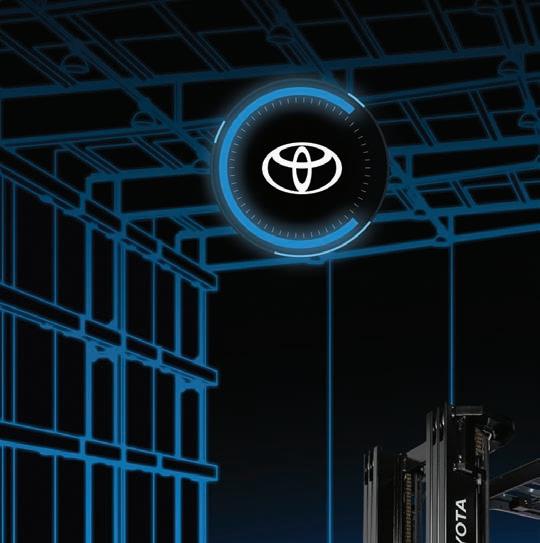














CBRE’s Daniel Eramo and Todd Grima negotiated a deal on behalf of Melbourne Airport and Honda Australia to grow the airport’s Business Park precinct with a 22,800 sqm facility.
The investment management firm says Daniel acted on behalf of Melbourne Airport while Todd acted on behalf of Honda Australia.
Melbourne Airport notes its new facility will become the company’s national parts DC, replacing two nearby facilities, and it includes 500 sqm of office space and sits on a 40,910 sqm site.

It adds that construction of the new DC started in June this year with Honda expected to move into the purpose-built facility in Q3 2023.
Andrew Gardiner, Melbourne Airport Chief of Commercial Property and Retail, says he welcomes Honda to the estate, adding that he was thrilled to have another international brand recognise the value of the airport’s location.
“Honda is a global brand known for its automotive, motorcycle and power equipment products, and we are pleased
that we are able to offer them our unique location to support their local business objectives,” he says.
“While our main business at the airport is of course aviation, our commercial property business also underpins our success, and that was particularly apparent throughout the pandemic.”
Melbourne Airport says Business Park is Australia’s largest business park, spanning more than 500 hectares.
The airport offers tenants like Honda fast access to air freight, on-site 24/7 security, and close connections to arterial roads so that they can get their products to their customers quickly and easily, notes Andrew.

Stephen Collins, Honda Australia’s Chief Operating Officer, says the company was excited to be moving ahead with the next phase of its business transformation plan.
He adds that Honda is now making significant investments across the broader business to strengthen local operations.
“We will be bringing our automotive,
BPS Global Australia says it has partnered with Harvey Norman Commercial Division (HNCD) to deliver a range of automation technology at its new $14 million facility at Crossroads Logistics Centre.
AMP Capital owns the state-of-the-art facility in Casula in Sydney’s southwest while Dexus is leasing the building to HNCD.
The property is 18,000 sqm and will be completed in early 2023. BPS Global Australia is working with HNCD to cater for a rapid rise in growth and demand by installing and using the latest automation.
“We’re delighted to deliver a full range of state-of-the-art technology for Harvey Norman Commercial Division as the organisation expands its fulfilment capabilities with a brand-new facility in Sydney,” Malcolm Druce, Managing Partner at BPS Global Australia, and Project Manager for HNCD, says.
“As part of Harvey Norman Commercial Division’s commitment to innovation, they have invested heavily in automation technology that will transform its operation and increase efficiencies, accuracies, and speed for its end consumers,” he adds.
HNCD provides an extensive selection
Melbourne Airport’s new facility will become Honda’s national parts DC, replacing two nearby facilities.
motorcycle and power equipment parts warehousing and distribution together at the new, purpose-built facility,” he says. “As ‘One Honda’ in Australia, we will have greater scale to realise our full potential and best serve our diverse range of customers.”
“The process undertaken identified Melbourne Airport as the ultimate location for Honda’s new distribution centre,” Todd says. “It ensured the right building solution could be delivered and matched with competitive market terms.”
of brand-name products to builders, developers, architects, and designers, notes BPS. It is also responsible for delivering business reward products via frequent flyer scheme and company incentives.
It says this division has seen record growth and as a result HNCD has invested in automation at its new facility to significantly expand its Stock Keeping Unit (SKU) capacity.
“We’ve experienced rapid growth across our service offerings in the past couple of years and have made the decision to invest significantly in our supply chain capabilities,” Alan
For RedMart, Singapore’s largest online grocery retailer, order fulfilment speed, reliability, accuracy, and productivity are key in delivering on customer promises, especially during the pandemic, when online visitors increased 11-fold.

Optimising capabilities through leading-edge logistics automation from Dematic, RedMart’s online fulfilment centre features robotic shuttles, ergonomic pick stations, intelligent conveying, and high-rate despatch sortation – all across five temperature zones and managed by sophisticated software, making grocery fulfilment easy, accurate, efficient and safe.


Stephenson, Proprietor HNCD, says.
“By partnering with BPS Global Australia, we’re confident we have selected the right automation and tech suite for our operation and look forward to delivering the very best experience and service for our customers.”
BPS says the facility will be able to store more than 60,000 SKUs across 18,000 sqm, compared to 20,000 SKUs across 12,000 sqm at its current facility in Taren Point.
HNCD has invested in Autonomous Case-handling Robots by Hai Robotics, automated packing machinery by CMC, very narrow aisle trucks by Toyota Materials Handling and a state-of-theart Warehouse Management System by Thomax Technology.

Paul Graham, Group Chief Executive Officer and Managing Director says despite the growing headwinds this was a solid result.
“I am immensely proud of how our people have met the challenges of a global pandemic and still delivered essential services to all Australians,” Paul says.
“Not only did our team work tirelessly to keep themselves and their communities safe, but this was achieved in an environment of evolving restrictions,” he adds. “I’m pleased we were able to deliver a record number of parcels and expand our range of services, connecting all Australians during this difficult time.”
AusPost says is expected to remain in FY23 due to elevated volumerelated costs and COVID-19 related workforce impacts.
“While it’s clear more Australians are buying goods online following the pandemic, we don’t expect to see the same level of e-commerce growth,” Paul says.
“This has been demonstrated in our second-half results and, going forward, we anticipate growth to be moderate,” he adds.
Australia Post says its Full year group revenue for FY22 was $8.97 billion, which is up 8.5 per cent from FY21 and attributes strong first-half parcels revenue to driving the growth.

It notes e-commerce returned to normal growth rates and letters volume continued to decrease in the second half of FY22.
Sales of surplus assets and revaluations, as well as favourable bond rate movements supported Full year Group profit before tax of $55.3 million, including letters losses of $255.7 million, notes the national postal service.
It says after a strong first-half profit, the second half incurred a loss of $144.5 million, which it adds is considerably higher than in previous years.
Operational costs increased by 9.2 per cent on last year, some of which
He says despite the significant financial headwinds, Australia Post is focusing on business efficiencies, while continuing to invest in its network and technology, to better meet the needs of its customers.
Australia Post says more than $1 billion has been invested in it over three years to better service customers, with $427 million invested in new parcel facilities, fleet, and technology in FY22.
It adds that it invested an additional $17.1 million into the Licensed Post Office Network, bringing the total paid to Licensees in FY22 to $536.6 million, supporting the important role of Post Offices in communities across Australia.

WiseTech Global, provider of logistics execution solutions says it has partnered with ZIM Integrated Shipping Services, a global container liner shipping company to improve customer experience by connecting data via systems.
It notes that while supply chain visibility is increasingly important for logistics businesses, access to realtime, operational data is what drives critical decision making in an everchanging industry landscape.
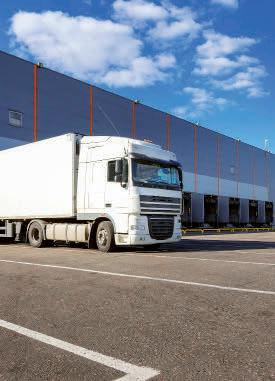

CargoWise ZIM data connection now provides CargoWise customers with direction electronic messages for schedules, booking, tracking, verified gross mass, shipping instructions, and bill of lading data.
“ZIM makes digitisation a priority, and providing our customers with an easily accessible, digital way to connect directly gives us the ability to provide the best-in-class multiservice care we are known for,” Karin Schweitzer, VP Global Customer Service ZIM, says.
“As a platform used by some of
the world’s largest global freight forwarders, we’re pleased to be working with WiseTech Global and CargoWise,” she adds.
She says this connection will serve both companies as mutual customers will get faster and more reliable confirmations and information regarding their shipments.
Removing the limitations of using a third-party connection, CargoWise is broadening the scope of connectivity customers can access while on the platform, enabling both freight forwarders and carriers to exchange relationship-specific information that helps with process automation, reporting and visibility, notes WiseTech.
“ZIM is an important addition to CargoWise’s extensive carrier connectivity network,” Ashley Skaanild, Regional VP – Logistics Data and Connectivity, WiseTech Global, says.

“This collaboration empowers CargoWise customers with unparalleled, rich data at their fingertips through one integrated
platform,” she adds.
She says ZIM and WiseTech will continue to build on the benefits of their partnership as they work together to enhance connection with even more functionality, like contract and spot rates.
“It’s exciting that we’ve reached a milestone with our ocean carrier connectivity – over 95 per cent of ocean cargo managed by our customers through the CargoWise platform can be booked through a direct connection to ocean carriers and NVOCCs.
“This is extremely beneficial to all parties. We’re streamlining the supply chain by enhancing cross-border operations and providing access to essential information via electronic exchange of data. This is the future of the logistics industry.
Ashley says the companies’ vision is to be the operating system for global logistics, and their focus will continue to be to scale and build out the Cargo Wise ecosystem to provide their customers with leading solutions that meet their diverse needs.

Experts across all industrial property types in Australia


factories, manufacturing
warehouses, cold-storage and data centres.

Simon Andreatta
Accelerating
As the labour market tightens, demand for supply chain and tech talent is at an all-time high. With the skills shortage posing a major threat to organisations’ resilience, efficiency and profitability, Körber Supply Chain takes a deep dive into what’s driving the labour shortage and how businesses can better retain, attract and upskill their workforce.
According to recruitment firm Hays, more than 91 per cent of Australian and New Zealand businesses are currently experiencing a skills shortage. The Hays Salary Guide 22/23 revealed 83 per cent of responding businesses stated the insufficient supply of local skilled professionals will hinder growth and operations this year – the highest level the recruiter has recorded in the 43 years it’s been producing its report.
The talent crisis is being felt around the world, in every region and
sector. In supply chain and retail, the pursuit of customer satisfaction and efficiency is the driving force for many businesses, and as a result sourcing and retaining labour has become extremely challenging.
“The supply chain is facing competing customer demands for faster delivery, and more product choice, all against the backdrop of unprecedented labour shortages,” Anthony Beavis, Managing Director APAC at Körber Supply Chain tells MHD
Finding and retaining labour is one
of the biggest challenges facing supply chain businesses today. In a recent Körber Master Class Survey, 73 per cent of respondents indicated that it takes at least 30 days to fill an open warehouse position.
Not only is there a worldwide shortage of staff, but it is also becoming increasingly difficult to attract workers into a warehouse environment that can be both physically demanding and dangerous.
Combine this with low pay and the constant pressure for efficiency and

Employees are motivated when they feel valued and can create impact.
consumer satisfaction, and you have a perfect storm of worker disinterest and dissatisfaction.
However, according to Körber’s Anthony Beavis, the skills shortage presents an opportunity to redefine the way we work, including the way we value our employees.
“Without productive, efficient and motivated teams a supply chain operation simply cannot serve its customers. We know that employees are motivated when they feel valued and can create impact. To compete for talent in today’s environment, we need to make sure all employees feel valued by using technology to create an optimised environment for them to thrive in,” Anthony says.
Against these challenges, technology offers a solution, unlocking new operational savings while supporting employees to work more safely, enthusiastically, and productively.
Introducing the right technology, in the right place, and connecting it with the workforce and the warehouse system, will enable organisations to build the supply chains needed for the future.
With warehouse managers under increasing pressure, they now must find, train and engage staff to manage the demands of growing customer expectations, expanding product lines and unexpected peaks.

Today, Körber customers around the world are leveraging the benefits of advanced technology to improve efficiency and productivity and increase employee safety and engagement.
One highly agile and flexible solution is voice-directed work (VDW). During the early stages of the pandemic, one of Australia’s largest retailers worked with Körber to become the first Australian retailer to deploy Android Voice based systems throughout its
“ Any solution needs to match the scale of your operation, and offer benefits from both a safety and an efficiency perspective, encompassing the requirements of both your business and your workforce. ”
Anthony Beavis, Managing Director at Körber Supply Chain, explores how businesses can better retain, attract and upskill their workforce.
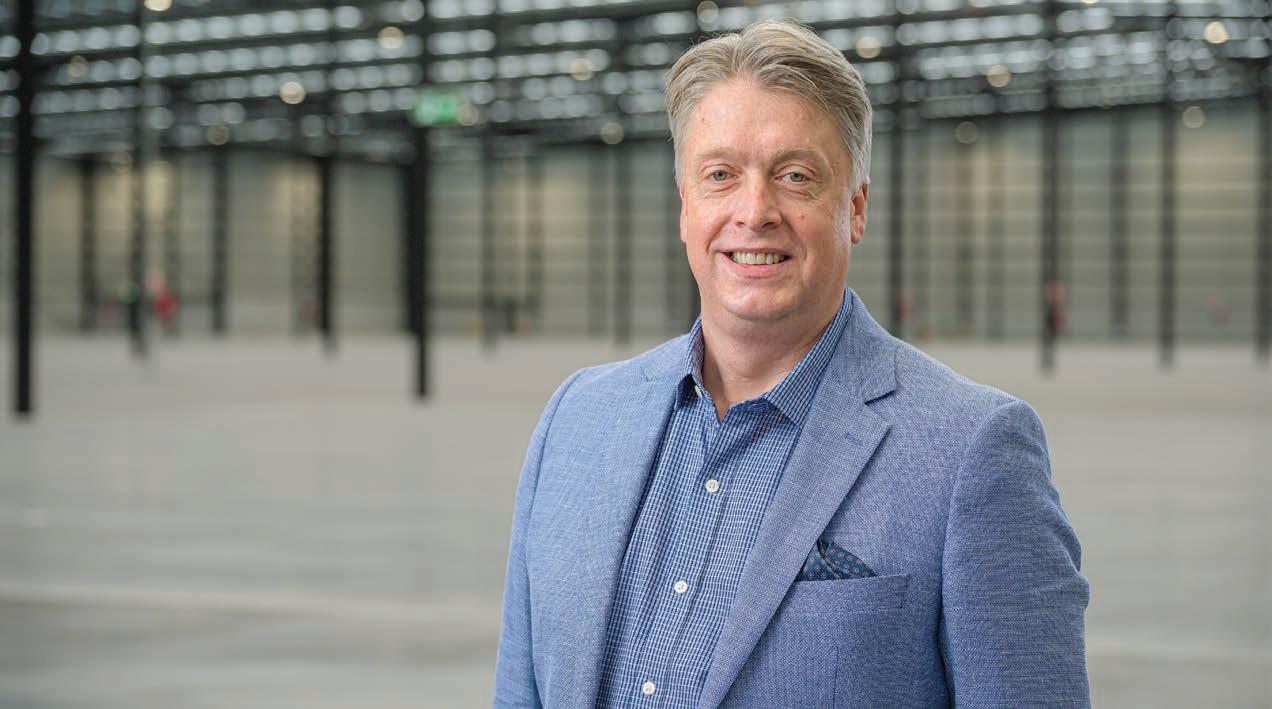
retail fulfilment operation.
The Android Voice solution guides employees with online and instore order fulfilment – improving productivity, reducing errors and safety incidents, as well as

Voice technology has proven to improve productivity by 35 per cent and reduce training time by 50 per cent.
decreasing training time.
By blocking out the noise of the warehouse and streamlining worker activities, VDW can improve accuracy, productivity, and safety across various functions in the warehouse including picking, putaway, replenishment, cycle counting, receiving, inspection and line loading.
In some use-cases, VDW has proven to improve productivity by 35 per cent, accuracy by up to 85 per cent, reduce training time by 50 per cent and importantly, reduce employee turnover by 50 per cent.
A further opportunity to tackle labour challenges with technology is the use of Automated Mobile Robots (AMRs). In the APAC region, Körber has been working with several major logistics providers and retailers to boost efficiency and help tackle labour shortages with agile and flexible automation.
Equipped with a combination of sensors, vision systems, and sophisticated mapping software that allows AMRs to respond in real time to changes in the environment, these robots can move independently
around the warehouse, avoiding people and objects.
Many are fitted with screens that help assist warehouse workers, with details of what needs to be picked or put away. Ideal for scaling up and scaling down, they help organisations rapidly meet peak demands and can move goods more efficiently around the warehouse than traditional picking methods.
They also reduce the steps and movement that warehouse staff have to make, which not only improves productivity but reduces the risks of slips and falls, repetitive strain injuries and fatigue or fatigue-related accidents.
During the challenges of the pandemic, a record number of retailers and logistics providers explored the use of AMRs in their operation. Most recently, a major Australian department store retailer announced it will work with Körber to deploy more than 200 AMRs at its new national distribution centre.
This major commitment to AMR technology will make the leading retailer the first in the world to boast three different AMR technologies – Geek+ RS8 Shuttle, P800s and Körber’s sortation solution,
Technology can be used to fulfil the needs of both the customer and the employee.
the site will also be the largest Geek+ RS8 Shuttle implementation in the Southern Hemisphere.
Rather than be a cause for conflict, technology can be used to fulfil the needs of both the customer and the employee. With careful planning and consideration, the introduction of selected technologies can be a costeffective way to improve product quality and choice, while simultaneously driving safety, productivity, and worker engagement.
“Any solution needs to match the scale of your operation, and offer benefits from both a safety and an efficiency perspective, encompassing the requirements of both your business and your workforce,” Anthony Beavis says.
Another major Australian retailer is working with Körber Supply Chain to deploy advanced technology to not only improve fulfilment capabilities but benefit the wellbeing of its team members.

As the organisation grows, the retailer maintains focus on its team members and their wellbeing. As a result, it has explored technology that enables it to not only fulfil at an increased speed and
rate but improves the environment for its team members.
“At Körber, we look at technology with a much wider lens and as such it has been great to deliver some further benefits for our customers around sustainability, employee wellbeing and occupational health and safety,” Anthony says.
Whether an organisation needs to respond to peak demand or manage crises, increase employee awareness and social distance, expand product lines, or adapt to new regulations – technology is available to support.
“Whether your organisation is national or international, single warehouse or multi-distribution centre, single channel or omnichannel, there is the technology to match and scale to your needs,” Anthony says.
However, whatever technology is deployed, labour will always remain the cornerstone of any operation.
“That is why the needs of your workforce must be considered in every technological decision. Using technology as a tool to augment and support employees to do their jobs better is the secret to keeping them safe and on side,” Anthony concludes.
■
Is your organisation experiencing a shortage of labour in supply chain or logistics roles?
The impact has been twofold –there is a shortage of available labour but more severe is the reduction in capability and accountability across the temporary workforce. For every 10 applicants we experience an average of two or three we want to retain for the next day. For 12 months now, labour supply has been limited particularly where MHE licensing is involved.
What is your organisation doing to alleviate the labour shortage issue?
We have successfully converted a percentage of our higher performing temporary staff into permanency and concurrently de-risked the labour shortage by offering a wider spread of hours to the temporary workforce. We have also moved away from a high reliance of MHE licensed operators and increased the spread of labour hire agencies across our business.
Moving into peak period, do you think this issue is going to get worse and if so, what plans do you have in place to help with this challenge?
Last year escalated from mid-July and this year was the same as more businesses hit their “peak”. As a result, this year we began recruiting earlier to gradually pick our way through and find the talented workforce.
How do you think the industry can do more to attract a wider pool of talent to help solve this issue?
By allowing the aged workforce with the correct skills, aptitude, and attitude back into the workforce. We must also be allowed to maintain a flexible industrial workplace platform to allow supply chains to become more efficient from a labour perspective.
The importance of attracting and keeping female talent in supply chain has been an increasingly hot topic over recent years. Prological’s Michelle Powell and Kelly Borskjaer discuss their experiences in the industry, what needs improving, and what is already being done well.
Much has been made of the importance of getting more women into supply chain. However, how this is best done – and the importance of taking active steps to achieve a more even male-tofemale ratio in the industry – is still a matter up for debate.

Prological’s Michelle Powell, Senior Analyst, and Kelly Borskjaer, Bid and Brand Manager, are two leaders in their field who spoke to MHD to share their perspectives on this vital issue: how the industry has developed, and what work still needs to be done.
Michelle, who has worked in the industry for almost two decades, says there has been a big shift in the composition of the work force.
“I studied science and engineering at university and was used to being almost exclusively with boys early on,” Michelle says. “But to
be honest, it wasn’t something I thought too much of. I’m fortunate in that I had great experiences during my entire career primarily due to supportive direct line managers.”
Michelle spent almost 16 years at Kimberly-Clark, which she credits with having a “progressive culture”.
“During my tenure there definitely was a shift towards more women in the industry,” she notes. “When I started out, I might have been the only woman in a room full of ten people. But 16 years later there were many more women employed with engineering or science degrees, particularly in the technical and quality assurance or planning areas where I worked. So, there was a big shift in terms of the composition of the workforce.”
What accounts for this change, in Michelle’s view?
“I think the change stems from having visibility of the opportunities available from an early age,” she says. “I went to a girls’ school, finishing in 1990. One thing I remember is really wanting to study engineering drawing – and not having the opportunity to do that.”
But Michelle says this is the only real hurdle she can recall in her career.
“Once I got to university, and then into the workforce, it just completely changed. I didn’t feel restricted. I didn’t feel any negativity or that I was limited in any way because I was a female.
“My impression is that school has definitely changed, girls are encouraged more to do whatever they want at an early age – and especially STEM subjects. It’s all over the media, and government is pushing for more young women to
pursue careers in STEM. The opportunities that are open for women is so much more visible now than it was in the past, which is great.”
Kelly Borskjaer is relatively new to supply chain, having joined Prological in March of this year to work on bidding and proposals processes, after working 20 years in the engineering and consulting sectors.
“Coming from the engineering services field, I would say that sector is still very male-dominated,” Kelly says. “But my impression is that a large part of that has to do with where one starts one’s career progression – up until recently, young women haven’t been encouraged in pursuing a career as, say, a technician, which is where you start before becoming a service manager, then a general manager. I’ve only been in supply chain a short time, and my general impression is that it’s quite similar. But like Michelle, this doesn’t strike me as unusual. The difference is that these days there’s more of an active push and visibility around women being in the sector as a viable career path from an early age.
“But speaking from my own experience across the engineering and consulting fields, and now in supply chain, I’ve never felt there has been a barrier to my progress.”
Michelle notes that part of reason she has never felt hamstrung in the industry is because her experience at KimberlyClark was very positive on a cultural level.
“The policies they had around maternity leave and pay were always good,” she says. “Pay was based on job description. I do remember, after returning from 12 months of maternity leave, my pay had fallen below the midline. But fortunately, my boss went right in to bat for me and the issue was rectified. So, company culture is really important, and so long as an awareness of and emphasis on having a female-friendly culture is front-of-mind, that’s the main thing.”
Michelle adds that at the end of the day, it should just be a true meritocracy.
“Firstly, you’ve got to have women who want to do the job. That’s where the issue starts. Now, it might be a case of women not being sufficiently aware or feeling enabled to do these jobs – in which case I’m all for opening those avenues. But we must also realise that women, and increasingly men, may have different priorities at different times of their lives – structural change is important in
When it comes to shifting the ratio more towards women in the industry, measures should be squarely focused on promoting the attractiveness of the industry and opening up pathways for their meritocratic advancement. That’s where companies in supply chain should be putting their focus.
”
supporting that family-life balance that we all are looking for, but time out of the workforce can definitely impact on career trajectory.”
Kelly agrees with this assessment, saying that awareness of the sector and an inclusive culture will be the primary determinants in getting those women who want to be working in the field working in the field.
“These sorts of questions can’t ever be boiled down to just one single factor,” Kelly says. “No doubt, there are still some people out there who think only people who look like them can do the same job – but they’re becoming less and less common in my view.
“But we should also be aware that supply chain and related industries will need to work hard to improve their attractiveness to women. For instance, there are industries which are simply more female dominated, and so in terms of competition for talent – supply chain might out-compete for attracting male talent, and other industries out-compete for attracting female talent.
“For example, I had a young woman working for me in the last engineering firm I was at. She was great, she loved the work – but,” Kelly laughs, “she was tapped on the shoulder by Louis Vuitton to come work for them. Between maybe a free air conditioner and a free handbag … what’s a girl to do?”
Kelly notes that at the board level across all sectors, including supply chain, there is a push to get more women in at the top.
“Given previous generational dynamics, I think it is important that mentoring processes are in place to ensure women who want to take that step up to the C-Suite roles can build the experience necessary for these roles.”
“I agree,” Michelle says. “Setting quotas on a process that’s quite multifactorial can create unnecessary angst in the workplace. No one who has earned their position on merit wants to feel undermined by any perception that they were promoted for non-meritocratic reasons.
“As Kelly says, when it comes to shifting the ratio more towards women in the industry, measures should be squarely focused on promoting the attractiveness of the industry and opening up pathways for their meritocratic advancement. That’s where companies in supply chain should be putting their focus.”
Colliers has currently appointed agents to several major developments in South Australia. Paul Tierney, National Director Industrial, is based in Adelaide – where he has witnessed vacancy rates hit historic lows and observed how the city’s industrial market has grown and evolved over the last two decades. He explains how the company is servicing the SA industrial market as it reacts to external forces and the changing economic environment.
Colliers Industrial property is currently dealing with changing market dynamics on both the sales and leasing fronts. National figures show this year there’s been an even split between leasing and sales revenues – an uncommon occurrence.
Paul Tierney, based in Adelaide, is National Director Industrial at Colliers. He has lived in the City of Churches for the past 22 years and developed strong ties with SA investors, occupiers, and clients.
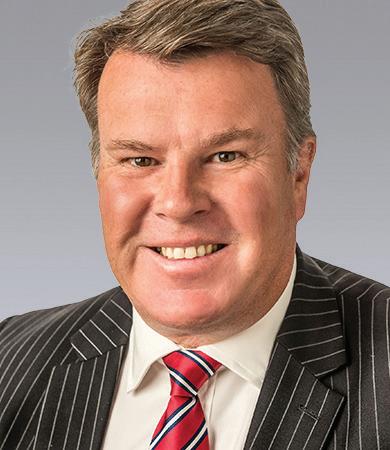
Adelaide’s industrial property market is smaller in size compared to the east coast markets of Sydney, Melbourne, and Brisbane. Paul and the SA team have extensive experience as specialists in the industrial market locally, supported by the National Industrial Team and broader business.
“We interact with interstate occupiers and clients that own and occupy property, but over 70 per cent of our market base is privately owned” Paul says. “We are trusted advisers to our clients. Our clients seek expert advice supported by data from us for leasing, brokerage, and sales as well as land division and developments.”
Industrial leasing focuses on existing vacant and design and construct opportunities while industrial sales focus on owner-occupier, vacant possession, and investment sales.
“Within Colliers, we have two key internal teams in the industrial business
– the Capital Markets and the Occupier Teams,” Paul explains. “I sit on the National Capital Markets and Occupier Teams. I meet with my colleagues regularly to discuss national market trends and the impacts they have on occupiers and investment sales in South Australia.”
He suggests more than 50 per cent of tenant and occupier demand is warehousing and logistics related. There is also growing interest and enquiry from advanced and, to a lesser extent traditional, manufacturing and other professional service providers who need to own or lease industrial assets.
“Our market is broken up into five key submarkets,” Paul says. “There’s the outer north, Edinburgh, Direk, and other nearby suburbs. Then there are the traditional markets of the inner north (Wingfield, Regency Park, and Gilman). There’s the west near the airport, and the inner south, including Edwardstown, and the outer south Lonsdale and Seaford.”
South Road is the main arterial corridor linking north and south Adelaide which is currently undergoing a significant upgrade over a staged process. Ultimately this arterial corridor will be the critical spine of Adelaide.
“Twenty-odd years ago, when I moved to Adelaide, the core industrial market was in inner-northern areas. It has now grown with emerging markets in the outer north and outer south becoming more popular.
Land values have improved and continue to keep growing
with pressure from higher and better uses in near city markets.”
Average land values on near city suburbs range between $700 to $1000 per sqm. The further you move away from the CBD the more affordable the land becomes, with pricing in the outer north and outer south now ranging from $175 to $200 per sqm upwards.
Development and opportunities follow infrastructure, notes Paul. With pressure on land from higher and better uses such as residential and commercial we are witnessing a migration of industrial occupiers to infill development locations in the traditional markets and expansion to the emerging industrial markets.
The upgraded South Road will provide development opportunities for higher and better use, but also makes movement of
product through the state and capital city a lot easier.
“Certain major routes that get used are susceptible to congestion,” Paul says. “South Road will reduce the congestion and improve traffic flow through some key residential suburbs in the east and west, particularly with the central corridor.”
“It will also mean that we can move product between southern and northern facilities. These warehouses and DCs will be smaller. This is important as e-commerce rapidly grows and customers want their purchases within a matter of hours and days, not weeks. We anticipate more of these smaller DC facilities that can quickly distribute items moving forward.”
Once connectivity to the ports and terminals in Adelaide is improved, containers will move more easily and can be transferred more directly from the port to rail and road networks. The investment in road, rail, and port infrastructure is crucial to this process.
Colliers was involved in the Walker Corp Development, The Vicinity Industrial Base from the outset. This was a 90-hectare parcel of land. Paul explains, “the first 10 years were a bit slow because of the amount of availability within the inner north, which is where occupiers had a preference to be because of the network and transport operators.
“With the development of the Northern Connector linking the South Road, Port River Expressway and the Northern Expressway, Stages 2 and 3 sold out within 12 months, with Stage 3 not even being formally released to the market due to pent up demand. This is a clear indication of how improved infrastructure supports new development and allows occupiers to relocate to these emerging suburbs.”
With the lack of supply of existing leasing stock, pre-commitments are key to satisfying occupier demand. The Adelaide market does not have
speculative development like other eastern seaboard markets.
With the current vacancy levels many of the existing opportunities have short term occupiers renting these premises adding more pressure to supply, Paul explains. New vacancy coming to the market is generally snapped up quickly due to increased demand for warehousing and logistics facilities. The focus is more towards a flight to quality, steering clear of these old and inefficient buildings.
“Internal clearance for those older buildings is often six to seven metres, whereas most new buildings have springing heights of 10 to 12 metres, and maximum internal clearance up to 13 to 14 metres. Efficiency in automation and supply chain technology is forcing these changes.”
Paul notes that with this trend continuing businesses can expect to see “dark warehouses.” These are fully automated warehouses that require limited human operators.
While multi-storey warehousing will be coming to the more land constrained markets of Sydney and Melbourne, these facilities will only possibly appear near Adelaide’s main airport and where land pricing and supply are constrained.

Colliers has two new leasing development opportunities in Wingfield. 2 Francis Road for Charter Hall, called the Wingfield Industrial Estate, will be developed in two separate warehouses providing more than 14,000 sqm and will offer ESG initiatives to attract larger corporate occupiers. With strong leasing enquiry Colliers anticipates these warehouses will be pre-committed and developed in 2023.
“The other development is Wingfield Logistics Park, a 13-hectare site that Fife Capital is developing including a pre-commitment to Blue Star Logistics. The further development of two larger 9000 sqm buildings due for completion in late 2023 are already attracting strong interest from the market and we would expect these to be leased before
practical completion. Further stages within Wingfield Logistics Park can accommodate pre-commitment occupiers to the estate.”
Colliers has identified trends in SA that mirror those occurring nationwide, with a particular focus on infill development options.
“There’s appetite for land-rich sites, especially short-term leases, however long WALE assets are still attractive to REITS and syndicated purchasers,” Paul explains. “We are still experiencing strong demand from offshore and onshore capital seeking investments in the industrial asset class. Limited opportunities in this sector are helping to hold yields relatively firm. We anticipate investor activity to grow as inflationary pressure and interest rates ease.”
Investors are attracted to South Australia not only for the value proposition comparative to the eastern seaboard, but also because of the removal of stamp duty on commercial property transactions.
“Taking five per cent off your purchase costs at the upfront has a massive impact on investors, and with the softening of yields, I think it will keep attracting them to South Australia.”
In line with the national trend the Adelaide industrial markets are witnessing sustained rental growth. This rental growth is supported by limited supply and the opportunity for some older facilities to be refurbished and repurposed to accommodate modern warehousing and logistics demand.
A good example of this is 7 Brandwood Street, Royal Park which Colliers sold to Centennial last year. The 12,000 sqm building is being refurbished with completion in late 2022. It anticipates the building will be fully leased prior to practical completion of the refurbishment.
“We’ll see a lot more of these refurbishment opportunities as sites are brought to market, particularly in areas like Regency Park and Wingfield. We may even see speculative development of larger facilities to cater for the increased demand.
“Given the demand and the lack of supply, it’s the ideal time for developers if they’ve got that appetite to do it here.” ■


A family-owned Queensland nursery wins free TMHA electric pallet jack after forklift purchase.

Afamily-owned contract growing nursery business has enjoyed a welcome bonus after becoming a customer of Toyota Material Handling Australia (TMHA) for the first time.
Growing Solutions Australia, based in Cabarlah, Queensland, wanted to purchase its first forklift and chose the superb safety and reliability of TMHA by opting for a Toyota 8FG18 counterbalance forklift to best complement the business.
However Growing Solutions Australia owner Jamie Currie got more than he bargained for after ordering his new forklift, with TMHA area sales manager Max Reindl assisting Jamie to enter into a competition to win an LHE150 electric pallet jack.
As luck would have it, Growing Solutions Australia proved to be a winner in TMHA’s Grower’s Prize Giveaway promotion with Jamie particularly pleased at the result.
“We don’t win a lot of things but it was brilliant to get the phone call,” he says. “Max recently delivered the product and went through the product familiarisation, and now we have not only a forklift but a brand-new electric pallet jack.”
“Sometimes you’re just happy with the meat tray at the pub, but this time we won an electric pallet jack, which is great!”
Having started Growing Solutions Australia five years ago with his wife, Jamie had previously been using an old forklift that came with the Cabarlah nursery when he
purchased it.
However the need arose for a replacement, with Jamie canvassing the products of multiple brands but eventually settling on Toyota.
He says the advice of friends helped him make what was a simple choice in the end.
“One of my mates who also owns
Growing Solutions Australia was the winner in TMHA’s Grower’s Prize Giveaway promotion, receiving an LHE150 electric pallet jack as prize.
a forklift bought it through the same salesman, Max Reindl,” Jamie notes.
“I was talking to him, asking what forklift he got and he said, ‘I just got one recently, I bought it through Toyota, I’ll text you his details.’ It was as simple as that, he texted me his details and from there we made a very
simple purchase.
“Knowing that a colleague also purchased one through Max, knowing that it was a Toyota and knowing the Toyota comes with all these different benefits and its reputation, it was a simple decision for me.”
Jamie sung the praises of the TMHA team led by Mr Reindl, who facilitated a purchase process that was made as simple as possible.
“The whole purchase process was extremely simple,” he says.
“It was quote, the rep came out and saw me, met with me, discussed the machine, selected the machine, quoted, ordered, paid, delivered. They’re just simple to work with.”
Product familiarisation was also carried out upon delivery of the new machine - a process that was repeated a couple of months later with the arrival of the free electric pallet jack.
Having moved from an older competitor’s forklift, Jamie says the Toyota 8FG18 machine offered a significant step up in features and usability, making for a simple-tooperate machine.
“I’d just say that from the machine that I’ve moved from, from a business owner’s point of view there’s obviously the safety features, and it’s just a very smooth and easy machine to operate.”





With its class-leading safety features including Toyota’s exclusive System Of Active Stability, legendary reliability and excellent customer service, it comes as no surprise that Jamie has been pleased with his decision to switch to Toyota forklifts.
Additionally the prize of the LHE150 electric pallet jack was an added bonus as it features a compact design perfect for light applications, and a maintenance free lithium-ion battery for fast charging.
When asked if he would recommend TMHA to others in the industry, Jamie didn’t hesitate to say that he would “100 per cent” encourage others to jump on board.
“My response is very clichéd but if you look at people sharing their positive experiences in the media, mine is pretty much the same,” he says.
“From making contact with the rep, to the rep coming out and responding straightaway, to delivering and having the machine, it was all made very simple.
“And with the quality of the product - in my opinion, if I compare it to the quality of other products out there, it was a no-brainer for me to go with Toyota.”
Jamie and his wife started Growing Solutions Australia five years ago to work as a contract grower with businesses in the nursery, horticultural and agricultural industries.
The family-owned Queensland business now boasts eight employees from the local area across fulltime, apprentice and casual staff, predominantly working with wholesale nurseries in producing young plants.
■
For more information visit ww.toyotamaterialhandling.com.au
Leading forklift retailer Toyota Material Handling Australia (TMHA) has broken ground on a new home for its operations in Victoria, with the state-of-the-art facility to provide a range of functions for the company.
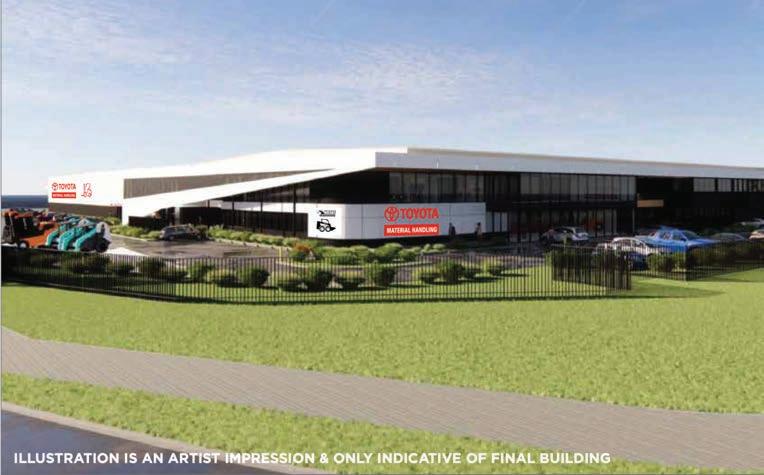
Located in Dandenong South in Melbourne’s south east, the new facility is approximately 5km away from the existing facility on Abbotts Rd and will offer a broad scope of capability for TMHA.
Having been in planning for five years from board approval to acquisition of land to commencement of construction, the new site sits on 32,600m2 of land - a significant 81 per cent increase over the outgoing facility.
The building area will take up half of the available land with 16,350m2 set aside for the facility itself - a 34 per cent increase over the previous building.
At 12,827m2, the new warehouse and workshop area is 28 per cent larger than before, while a new 300m2 ‘dirt’ demonstration area will allow for prospective customers to demo its HUSKI Construction Equipment range of earthmoving products.
In addition, the new facility will feature state-of-the-art sealed and pressurised paint and preparation booths.
TMHA GM Corp Compliance & Project Development Bob Walmsley says the new site would allow for a greater level of usability and innovation for the brand.
“With features like a dedicated dirt demonstration area, paint booths and support for parts and service, our new state-of-the-art facility will offer more for our valued Victorian customers.
“We all can’t wait to experience the fruits of this investment from TMHA and look forward to seeing the completed hub next year.”
Along with facilitating sales and rental of TMHA forklift and allied equipment, the new facility will serve as a regional base for major and corporate accounts operations, will hold inventories of new material handling and Huski construction equipment, and will offer full support coverage for parts, workshop and field service, and training facilities.
The purpose-designed new facility and the land it is built on is wholly owned by TMHA.
TMHA is also exploring other opportunities to expand its branch operations through regional Victoria. Construction of the new facility is expected to be completed in the first quarter of 2023.




















A leading global tax services and software provider has signed a reseller agreement with Geotab. Find out more here.
use of telematics data as a valuable data source in helping clients solve tax problems across a range of taxes globally, from fuel taxes in trucks to income taxes on company cars.

Ryan, a leading global tax services and software provider, has announced that it has signed a reseller agreement with Geotab, a global leader in IoT and connected transportation. This agreement will allow Ryan to serve as a one-stop shop to its clients. Through a subscriptionbased product offering, Ryan’s clients will now benefit from both Geotab’s telematics insights and Ryan’s specialist tax advisory and compliance services.
Ryan’s clients worldwide will be able to purchase Geotab’s awardwinning telematics device solutions. Combined with Ryan’s full suite of services, comprised of tax, consulting, and integration services, including existing integrations with enterprise platforms, the agreement enables Ryan to provide its clients with a telematics and tax cross-border offering that uses telematics data to solve complex tax challenges while making strategic business decisions.
“We are excited to embark on this new commercial journey with Geotab,” says G. Brint Ryan, Ryan Chairman and CEO. “This partnership will provide us with even more opportunities to assist our global clients. We’re seeing the
“These technologies allow clients to achieve better tax outcomes as well as more robust tax risk management. Combining the power of Geotab’s industry-leading telematics data with the experience and knowledge of a leading tax services firm will help our clients understand how they can use telematics to drive strategic business decisions and favorable tax outcomes.”
Geotab has shown no signs of slowing down, despite the pandemic. In August, Geotab announced it had surpassed three million subscribers across the globe, demonstrating the continued high demand for data intelligence to support rapid transformation of industry, including fuel and operating efficiency, safety, sustainability, and predictability.
“The unique intersection of Geotab’s telematics technology and Ryan’s tax
In August, Geotab announced it had surpassed three million subscribers across the globe.
services will provide Ryan’s clients worldwide with the opportunity to connect their vehicles to the cloud and, as a result, have better insight into their fleets and any related taxes,” says Neil Cawse, Founder and CEO of Geotab. “By taking advantage of Geotab’s telematics offering and the set of tax, consulting, and integration services from Ryan, clients will be able to make better decisions and save time and money, which can help advance their positions in their respective industries.”
For Geotab, which recently marked its 22-year anniversary, surpassing three million connected vehicles, and forming new and interesting strategic partnerships in diverse fields – as illustrated by the Ryan partnership – is indicative of the significant impact its high-quality data insights contribute to organisations across the world as they optimize operations, build safe and intelligent communities, and continue working towards their various business goals. ■

Hear more from our experts on our latest episode of Talking Property
the Fit Out of
No two logistics problems are alike. Neither are their answers. Each requires a point of view. A new angle. Together, we’ll look for an integrated solution, guided by data and insights. We’ll gain a deep understanding of your business, and consider every part of your commercial real estate strategy, so you can realise anything.



Stockland is developing logistics parks in the ever-growing areas of Sydney’s west and south-west. Tony D’Addona, Stockland Executive General Manager, Workplace and Logistics, gives insight into what’s going on in this space – and what opportunities will become available as sites like the Western Sydney Aerotropolis open in the coming years.
consideration is supply of employment lands,” says Tony. “Changing land uses over time, which we understand as a creator of masterplanned communities, have seen a reduction in employment lands – that is areas zoned for industrial or similar purposes – when they are rezoned for other purposes.
“When you combine these factors with the time it takes to rezone employment lands elsewhere, and provide the infrastructure for development to progress, supply has just not kept pace with demand.”
As two councils in Sydney’s south west gave the green light for the diversified property group to develop its Leppington Business and Ingleburn Logistics parks, Stockland has strengthened its presence in the west and south west where the Western Sydney Airport and Western Sydney Aerotropolis are set to become economic catalysts for the broader region.

In a constrained market with elevated occupier demand, Stockland is providing much-needed supply for customers who are looking for strategic locations in growing areas with access to working populations and key infrastructure.
While still making up ground on its Asian and European counterparts, Australia’s e-commerce market is growing rapidly. It’s a major factor
in driving demand for logistics space as online distribution requires a significantly larger footprint particularly when compared to traditional bricksand-mortar operations.
The change in consumer behaviour brought about by the restrictions and lockdowns during the COVID-19 pandemic show no signs of abating.
Disruptions in supply chain have also created a step change in the way businesses strategically manage their inventory. There is a growing trend from a ‘just in time’ to ‘just in case’ with businesses preferring to hold more stock to mitigate supply chain risks, meet unexpected demand spikes, and potentially lock in material costs. Onshoring of manufacturing is also expected as a consequence of the pandemic and deglobalisation.
“Apart from the obvious demand drivers at play, another key
It’s these factors that have led to previously unseen rental growth and record low vacancy rates and highlight the importance of a healthy, functioning logistics sector with the right facilities in the right locations.
For example, Stockland’s Leppington Business Park and Ingleburn Logistics Park in south west Sydney are masterplanned estates that offer premium warehouses with ancillary offices, 5 Star Green Star ratings, and connections to key road and transport networks.
As the Western Sydney Aerotropolis nears completion, the airport and its surrounding lands will play an important part in delivering growth by supporting employment, population, infrastructure, and road upgrades which will further increase the attractiveness of the region.
These market conditions are influencing Stockland’s customers – some need to

evolve their operations with bigger and more modern spaces, others want to downsize or take advantage of better locations, and some need to move to interim sites while they wait for their new premises to be completed.

“Many of our customers are looking to expand or diversify their operations into secondary markets,” says Tony. “We are working collaboratively with current tenants to place more than 150,000 square metres of demand across our portfolio and development pipeline.”
This highlights a point of difference. Stockland works in close partnership with its customers to leverage its diverse portfolio of assets and to ensure a smooth and effortless transition between spaces.

“Population growth within the Western Sydney region plays a major role in influencing the demand for logistics assets, with an anticipated growth rate faster than that of Sydney as a whole,” says Tony.
“A further contributor to population growth will be the increased migration cap, with roughly 35,000 permanent migration visas will be made available in the coming year to help ease critical workforce shortages.
“There will be a need for a thriving logistics market to service this surging population,” he continues.
“The region is incredibly well located
in regard to key infrastructure and the road and transport network.
“There is motorway access to key industrial hubs in the west, north west, and infill locations, the M5 delivers direct access to the existing airport and the ports, and it’s close to the Western Sydney Aerotropolis, as well as corridors to Melbourne and the ACT.”
As businesses grow and require bigger footprints, or more modern facilities, growth areas like Western Sydney are more desirable.
“While we are seeing customers migrate towards Western Sydney, we are also seeing major redevelopment potential in our infill locations,” Tony says.
“Many of our ecommerce customers operate a B2C model. Their customers are individual consumers, so they
Logistics space is critical for customers who are looking for strategic locations in growing areas, with access to working populations, and key infrastructure.
are targeting ‘middle and last mile logistics’ locations, close to major population centres. They may be using smaller trucks and vans and are happy to pay more for less space closer to the city.
“While the traditional logistics operators operating B2B models are more likely to gravitate west towards bigger warehouses, more hardstands, and are generally using heavier vehicle types.
“If the pandemic and current market conditions have taught us one thing, it is that logistics assets need to be viewed as critical infrastructure for our cities, integral to their ongoing productivity and the liveability of our communities.”
“Our western Sydney developments will generate job opportunities throughout construction, and as tenants and their employees move in”. ■
Argon & Co is a global management consultancy that specialises in operations strategy and transformation. With expertise spanning the supply chain, procurement, finance and shared
services, we work together with clients to transform their businesses and generate real change. Our people are engaging to work with and trusted by clients to get the job done.
VisionNav is a company on the rise off the back of the utilisation of advanced technology. MHD learns about the navigation technology behind VisionNav’s range of autonomous industrial vehicles.
VisionNav Robotics supplies autonomous industrial vehicles and intralogistics automation solutions for a range of clients around the world. Based on 5G Communication, AI, Environmental Perception, Deep Learning, Servo Control technology, VisionNav has developed nine automated product series including automated guided forklifts and tugger trucks for various scenarios.

Following huge success in Asian markets, VisionNav is making an impression in the Australian logistics space, with solutions covering the full stack of intralogistics scenarios, including core scenarios such as 12m high access, 1.9m narrow aisle access, unmanned loading and unloading of trucks, and multi-level racking and block stacking.

At the equipment level, autonomous forklifts move pallets and material
frames (this is also the most common material storage unit) of various sizes.
At the system level, VisonNav uses user management systems such as WMS/MES/ERP, by sending operation instructions to autonomous forklifts to achieve real-time matching between logistics and the information flow.
The Bright Eye system manages the production line area via realtime monitoring and promptly orders autonomous forklifts to provide raw material replenishment, empty pallet recycling, and provide offline support for finished products.
Thomas Wilson of VisionNav says the Bright Eye system is an AI device that’s based on repeatable learning –it can detect the pallet location and the pallet status in real time, he says. “And it sends that information back to the upper system. It can also detect humans within that area, providing additional safety should a human enter that environment.
The Bright Eye system is used for the pallet management between manual forklift drivers and AGVs operating in the same area safely.
“There’s no need for a manual driver to scan a pallet location once he’s removed that pallet from that area,” he says. “We can use the system in conjunction with other vision-nav systems that enables us to complete truck loading of multiple types.”
settings, without a need to modify the site environment and existing business processes.
“The visualized technology uses six degrees of freedom, multi axis movement, and that’s used for accurate and efficient execution of movements such as loading and unloading of trucks, picking and placing of pallets, stacking or putting pallets away into high bay racking,” Thomas explains.
“The technology uses multi sensor configuration for enhanced sensing and accurate identification of objects such as for searching for fork pockets, cage legs or spigots.
The VisionNav self-adjusting algorithm assists the AGV to pick up pallets squarely and in a centralised position, confirming that the first point of contact is correct, which means less pushback to customers on Brownfield sites to meet a perfect world scenario of hard stops, level floors and level racking.
Because of its hybrid nature, the VisionNav technology can adapt to existing sites and operations, lowering system infrastructure costs that are often hidden during the design phase.
VisionNav is capable of building up to 2000 machines per year, which helps to combat the current market supply challenges.
VisionNav is capable of building up to 2000 machines per year, which helps to combat the current market supply challenges.
VisionNav’s highly accurate navigation technology adopts 3D laser hybrid sensors to capture detailed information for indoor and outdoor
“VisionNav can still deliver AGVs within a four to six months period. We have local Australian and New Zealand distributors that can complete those installations, and provide services and support,” he adds. ■
With a diverse portfolio of assets nationally and a strong development pipeline, Stockland offers flexible solutions to evolve with your business.

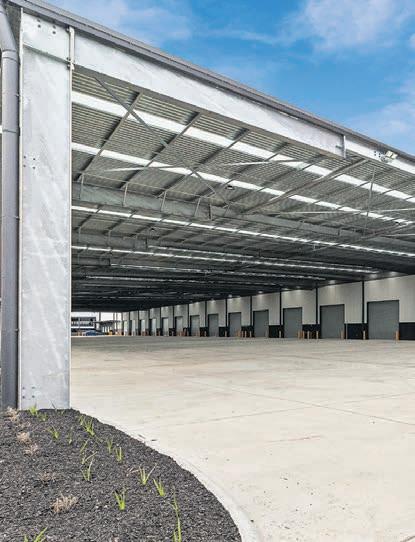
Find your space to thrive across our leading portfolio.
Position your business for growth, scan the QR code and enquire today.

2022 marks 150 years of DB Schenker globally, and 60 years in Australia.
our first day in business, we’ve kept our beginner’s mentality to find new and better ways to tackle tomorrow’s challenges and elevate lives.
committed to providing innovative supply chain solutions that challenge the status quo.
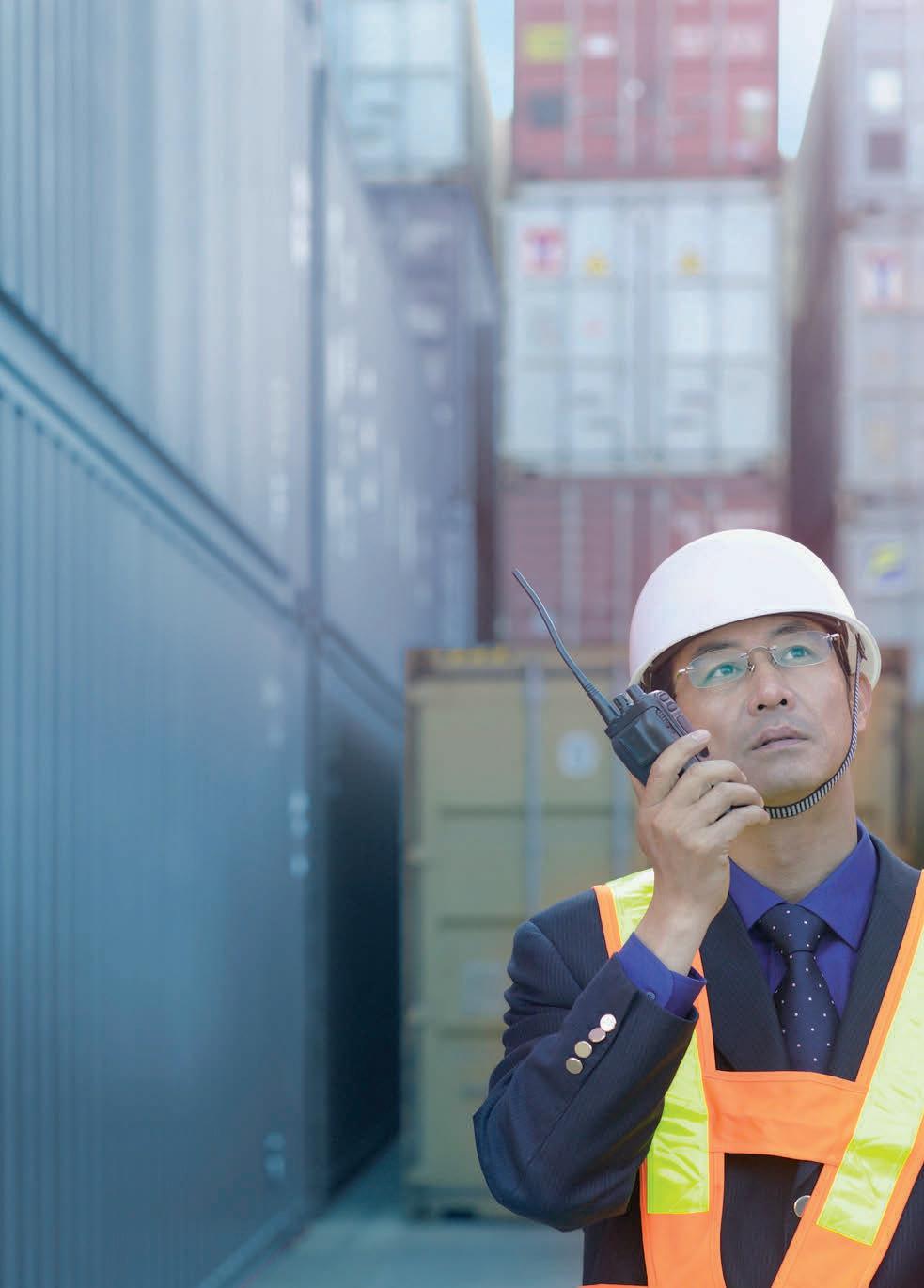
a global industry leader, we’re proud to support industry and trade in the global
of
Dematic’s Graham Lawrence, Jason Hill, and Jennifer Horton are some of the directors, project managers and engineers who facilitate project implementation capabilities for the intelligent automated solution company’s clients. They explain how the intricate process works, and why long-standing partnerships with customers are vital to its operations.
Companies looking to optimise their supply chain operations – to reduce their reliance on labour, increase storage and throughput capacity, increase order accuracy and speed, all in a smaller footprint close to customers –are evaluating implementing automation in their logistics operations.
In planning to automate, it’s critical that companies choose the right partner to work with from understanding their business and supply chain operations, their future growth strategies, designing a solution, through to system implementation, system handover and training, and ongoing service and support.
Critical to the success of the automated system – ensuring it is implemented to mutually agreed system deliverables and the project schedule – is the
project implementation.
Dematic has strong project implementation capabilities across Australia and New Zealand (ANZ). Its implementation teams work closely with all parties – including the builder, the company’s host software provider, and other key suppliers involved in the project – to ensure the best outcome is achieved for the customer.
The locally based, in-house experts in project management, engineering, controls, software, and go-live support reduce implementation time, cost, and risk. This includes dedicated project and site managers, engineers specialising in software, mechanical, electrical, structural, controls and systems, all collaborating to achieve the best result.
The Dematic team’s approach covers project safety, scope, timing, budgeting,
When planning to automate, it’s critical companies choose the right partner.
resource management, supply chains, quality assurance, and communications with customer and partner teams.
The process begins with Dematic analysing its customers’ entire operations – not only their supply chains. It looks at the business’s forecast – that is, where it’s going and what changes it needs to make as it moves forward.
It develops a system tailored to the business’s operations but with the necessary flexibility required. This is then handed over to the customer and the project team. Their partnership is constant throughout the entire project management process and helps the customer to become comfortable with using the automated systems to their full capabilities.
The Senior Enginners and Project Managers look at the technical aspects of a project, assessing durations and potential risks. Once the contract has been signed, the dedicated delivery organisation is engaged working closing with the sales and consulting team that designed the solution for the remainder of the project lifecycle.
There are more than 100 people working in the delivery side of Dematic in the ANZ region, including the many different types of engineers. This gives Dematic a diverse and deep understanding about delivering projects and means it doesn’t need to recruit many overseas workers.

“Our customers are dealing with the people who are going to deliver the job in the country,” Graham Lawrence,
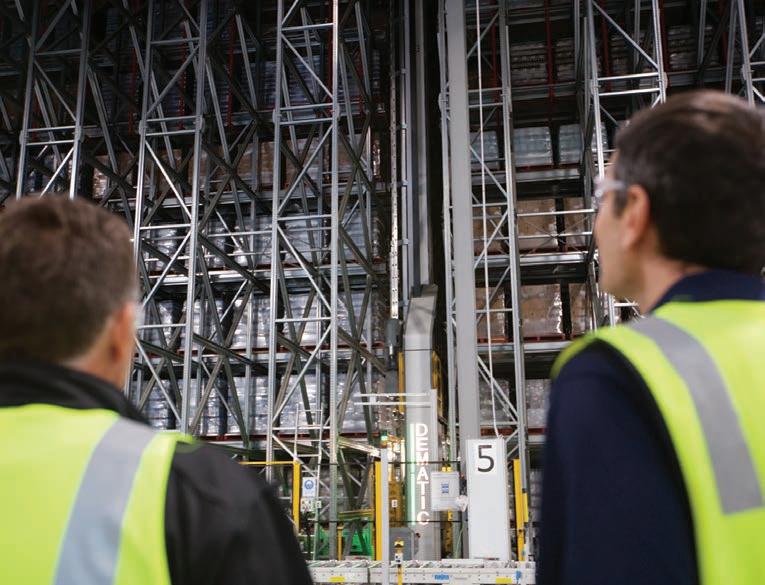
Director Projects ANZ/ASEAN at Dematic, says.
Dematic delegates the specific project – which takes anywhere between six months to three years to complete – to the suitable team to work on it.
“It’s all about forming a relationship with the customer and to understand their expectations,” Graham explains. “We have a process based on the Project Management Body of Knowledge, called PMBOK. The Dematic Project Excellence Process is based on this.
It’s a project management philosophy and process we’ve had for over the past 20 years which has served well in all our projects, including projects introducing innovations into the region for the first time
“It looks at the whole design process, but also considers the systems engineering approach. We’re not just providing products, we’re providing a system to a customer, which has multiple interfaces to host software systems into their operations, and we integrate multiple pieces of technology and software.”
Systems Engineering is an integral part of the project team. It initially focuses on the customer requirements in the early stages of sales, consulting and solution development. Beyond this, it focuses on executing them and delivering on customers’ requirements.
The engineers hold a series of workshops with clients to discuss what they have and know, and to review the solution layouts.
“We want to make sure it meets
resources. They also look after Dematic’s subcontractors and ensure the work is done safely, and that the equipment’s installed correctly from a technical standpoint.
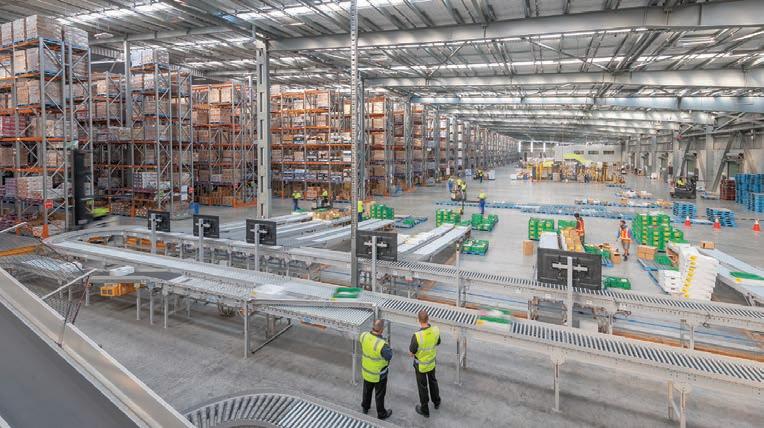

“It’s a much happier site environment when our safety officers check on our staff and continue to foster a cohesive workplace for everyone,” Jennifer Horton, Director Projects and Sites at Dematic, says. “We’re hitting schedules and maintaining our delivery timeframe.
“When there are shipping delays, we pride ourselves in working through those risks to minimise impacts to the client.”

their needs,” Jason Hill, Systems Engineering Manager APAC at Dematic, says. “We focus on their requirements, potential deviations that might occur, and track them throughout the process. Once we have system and functional specifications, we can execute on these during the project process.
“Before we even get to site, we start by conducting internal design reviews, software checks, and verify equipment performance. We begin with the basics, test each component, and build up with nodal equipment rates through to overall system performance.”
The Systems Engineers provide ramp up and operational support to customers. “We’re looking at the people on the ground, how they’re using the equipment, if they’re able to use the software efficiently, and we’re focusing on improvements throughout the process,” notes Jason.
“Systems Engineering is the bit of glue that holds it altogether,” Graham adds. “Each of the different disciplines has a role to play. Mechanical engineers will design a system and layout, and create a system based on various rates and performance criteria while the controls engineering team will look at how it’s electrically controlled and programmed.”
Dematic provides the inputs, controls, and software for the equipment it installs, and integrates third-party components as and where necessary to optimise outcomes leveraging mature relationships and technical solutions.
Project and site managers are assigned to manage and coordinate implementation
Dematic controls the inputs as much as possible and draws from its own key resources and scale of that support. In the initial stages of handover to the project implementation team, these teams are working with a builder to establish the building parameters and design they need to work around, as well as the timeframe.
The pre-construction phases are based on the engineers finalising the design, procuring the equipment, and preparing it all for ship to site. Once onsite, the teams install the equipment which is then followed by commissioning and subsystem testing before final performance and volume testing with the customer and their products.
“We practise the train-the-trainer approach,” Graham explains. “We train key personnel from the customers’ operations and have formal classroomtype training, and on- the-job training. It involves operating the systems, not only the software.”
The biggest differences between a major and a minor project are the risks involved and the team size, notes Jennifer, but the process itself remains the same. The project manager is responsible for coordinating the project and acting as its leader.
“Dematic is very much a customerfocused company,” Graham says. “We will not walk away from a situation, and we will always work with the customer and support them in their operations to ensure their systems continue to deliver to their business and supply chain requirements now and into the future. Testament to this is the number of repeat customers we have partnered with over the many years we have been implementing systems in ANZ and the broader APAC region.”
■

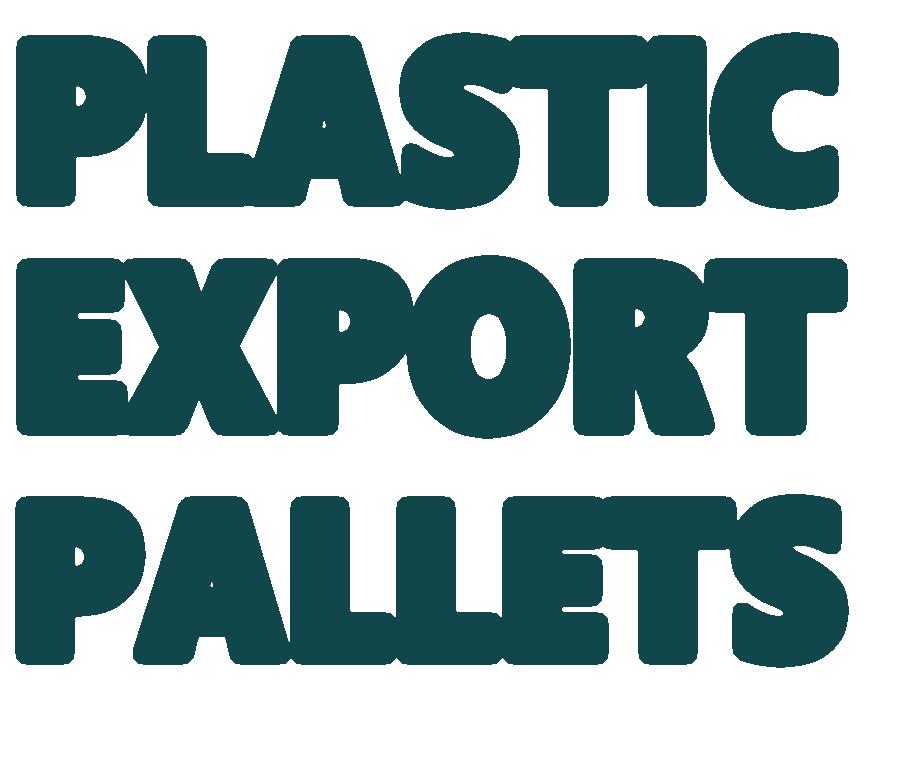





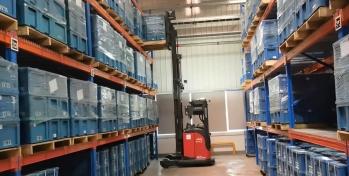





With vacancy rates at all-time lows, the Australian industrial property market is being forced to think outside the box. MHD speaks with property experts, Leedwell, about speculative developments and the future of the Adelaide and Melbourne markets.
Leedwell has been a major player in the South Australian industrial and logistics market for more than 14 years. Under the guidance of partner, Steve Smith, the same industrial team has been closing deals together for nine years – a testament to its synergy as a group.
Andrew Gerlach of Leedwell says it’s an unusual time for the Australian industrial sector, yet one that remains active and as exciting as ever.
“We’ve never seen industrial vacancy rates under one per cent,” he says. “It’s not just in the larger markets of Melbourne and Sydney – Adelaide has never seen rates below one per cent.”
Take-up in the industrial market has been astonishing in the past two years. In Adelaide, the low vacancy rate is a result – in part – to a lack of developers undertaking speculative development, which can’t be said for eastern seaboard markets where large developers are consistently creating new opportunities and being rewarded with take-up simply overwhelming the supply. With demand at an all-time high in Adelaide, developers have missed a golden opportunity.
“The take-up is moving from a justin-time to a just-in case situation,” Andrew says. “A number of our clients are in planning stages of large developments; however, a lot of that stock won’t hit the market – particularly in western and northern Melbourne markets, and in Adelaide until mid-tolate 2023.”
As supply struggles to keep up with demand for warehouse space in the South Australian market – especially
within 10 kilometres of the Adelaide CBD – a myriad of recent studies indicate the e-commerce shift continues to gather steam, suggesting the demand for automated fit-outs won’t dry up any time soon – if ever.

“It’s not just the big end of town,” he explains. “In the smaller end of the market – the sub-300 sqm units for mum-and-dad type investors or owner occupiers – there are many developments that are coming out of the ground that are having great success.
The market is trying to address the situation of low vacancy, but it does take time for speculative or pre-commitment development so there will be a hiatus of stock for a little while.”
Leedwell has been working closely with groups such as Sector Property on both smaller unit developments and small lot land divisions. Sector Property’s Managing Director, David Loakes, was an early adopter in this market and comments, “this end of the market, in the right locations remains an
opportunity for Sector to bring product onto the market for a broad range of our clients. We continue to review opportunities in Melbourne, but also interstate to satisfy this demand.”
The industrial market is heavily impacted by new, efficient infrastructure, explains Andrew, particularly roads. One clear example is the new Northern Connector expressway in Adelaide, which links Edinburgh Parks with more traditional markets, leading to significant land take-up in those markets. The completion of the Northern Connector resulted in improved land pricing and strong demand from developers to create development opportunities.
“Given the low vacancy rate, we’re encouraging our clients, both private and institutional, to take a leap of faith, measure the demand and look to build speculative developments in both Adelaide and Melbourne – rewards will be reaped by those who take action,” he says.
Owner-occupiers are also a strong market participant. Stock levels of existing buildings or development land for this market is also very low, resulting in participants needing to be more organised to capitalise on the right opportunity, especially given the current market conditions. Andrew explains that these groups should start planning at least 12 to 18 months in advance of a desired purchase.
“The key to that planning is knowing the right location for your business, key elements including supply chain, zoning suitable to intended land use, road restrictions for certain types of truck vehicles and of course, proximity of where staff live compared to the location are critical components of making these decisions.

“Another key consideration is affordability – do you need to relocate to an inner market, or can you go a little further out considering the scarcity of stock? These factors need to be established and planned out early so you can focus on where you want to move
your business.”
Another gem of advice for tenants looking to relocate is to keep an open and mature relationship with the existing landlord.
“Strong landlord and tenant relationships often allow for some flexibility so if you provide plenty of notice of an impending move, you are more likely to receive additional time if a property doesn’t eventuate in a timely manner. As investors, open communication is important as it allows them to plan for any upcoming vacancy and work with potential new tenants to limit down time and protect their income.
For non-income producing product (i.e., vacant land), the higher interest rate environment has momentarily cooled demand as businesses review operational needs and monitor market conditions. Andrew says despite not seeing any decrease in pricing, the levels of activity in market has recently settled, however the outlook remains bright for the industrial market.
“Most of the commentary we’re hearing from investors and developers buying land is that the current lull will not be a long-term issue because demand is so strong from tenants and owner-occupiers that people will reset themselves very quickly,” he says.
“Going forward, we are pretty bullish about the industrial market’s mid-term future.”


To demonstrate Leedwell’s commitment and view of the strength of the Adelaide and Melbourne industrial markets, the company’s property experts have recently grown their teams in both cities to ensure they have sufficient resources for the anticipated surge in demand.
“We think new land coming on will create opportunity for developers and others to crystallise the demand we’re experiencing,” Andrew explains. “We’re seeing trends coming to the Adelaide market from the eastern seaboard – a nationalising of the market between borders will be a trend we expect to continue.” ■
 Diverseco: Weighing, Dimensioning, Robotics, Packaging, and Inspection.
Diverseco: Weighing, Dimensioning, Robotics, Packaging, and Inspection.


Meaghan Siemensma, Senior Implementation Manager at Bestrane, was recently awarded the prestigious Contribution to Industry Award at this year’s Mercury Awards. Sponsored by the Supply Chain & Logistics Association of Australia (SCLAA) and judged by a panel of impartial experts, Meaghan may have been the only one surprised by her win – given her considerable track-record of professional and charitable achievements.
The Contribution to Industry Award was the final prize announced at the 2022 Mercury Awards.

For Meaghan Siemensma, Senior Implementation Manager at Bestrane – and winner of this year’s Contribution to Industry Award at the Mercury Awards, held in August – studying a Bachelor of Business (specialising in supply chain) at university in the 1990s was not an especially “strategic” choice.
“I knew I wanted to do something practical in business, and – although I didn’t think in such terms then – I was perhaps more attracted to the hands-on problem-solving aspect of the course compared with the alternatives,” Meaghan says. “I honestly didn’t know how great a fit it would turn out to be, and how fortuitous for my career.”
Indeed, it’s turned out to be the role
– or perhaps roles – of a lifetime.
Fiercely intelligent and devoted to her work, she rose quickly through industry ranks by virtue of her abilities and adventurous spirit. By 23 years old she was working in Singapore at BASF, before moving to the UK to work first in event logistics (“I got to see the Spice Girls, a highlight of course”) and spend a further six months doing charitable projects.
“That’s when I realised I really loved doing projects,” Meaghan says. “I like having a defined beginning, middle, and end. Maybe this is a fault, but I’m easily bored, so I like taking on projects full-steam ahead and delivering results effectively and efficiently.”
Her resume is too rich and various
to fully recount here, but in the years prior to joining Bestrane in 2015, Meaghan held major jobs at household names like KPMG, Toll, and CEVA Logistics.
Although far too self-effacing to spruik her own philanthropic activities, it became clear during her sit-down with MHD that volunteering to help charitable organisations and associations is a recurring theme in her life.
Indeed, it was through one such charitable project, for Meals on Wheels, that she first worked with David Sanders, Founder and CEO of Bestrane.
“At the time, the Bestrane team told me I was great with data and great with customers, which honestly surprised me, because I’d never
reflected on what skills I had – if any – that set me apart,” she says. “Sometimes, life is just lucky like that – someone brilliant sees something in you that you don’t see yourself.”
Soon thereafter, David offered Meaghan the job she has today. She’s been with Bestrane for seven years now.
“As a Project Manager and Senior Implementation Manager, my job is to understand what we’ve committed to with our client and work with our technical team internally, and then with the customer to get the software deployed,” Meaghan says. “It’s a fascinating job, because there are always new challenges, new opportunities. And I’m part of an amazing team at Bestrane that is the best at what it does and truly cares for people.”
She attributes the success of Bestrane, and her own success there, in no small measure to the man who hired her: David Sanders.
“I’ve worked with a lot of brilliant people,” she says, “but David is uniquely brilliant. He has a left-brain/ right-brain brilliance. Some people are lucky enough to be analytically brilliant, some are lucky enough to be brilliant with people. David is both – which is incredibly rare – and his passion and
energy are phenomenal.
“He’s got a great feel for people, and most of his hires at Bestrane have come about because he’s worked with that person before on a project, and got a sense of their talents and personality. He has an intuitive and intellectual feel for the intangibles that don’t show up in a standard half-hour job interview.”
This is, of course, how David came to bring Meaghan aboard seven years ago.
“But he also has enough confidence in his own people to delegate – he’s not a micromanager,” she adds. “And his generosity is boundless. Despite always being super-busy, just today he took two hours out to present to a group of Master’s Students at RMIT. He’s passionate about making a difference.”
Equally, David enthusiastically supports Meaghan’s extra volunteering work for the good of the whole industry. “Meaghan brings a whole bag of capabilities to Bestrane,” David says. “While we have no shortage of project work, most of this work is with clients that have been with Bestrane for multiple years, allowing her to leverage her amazing interpersonal skills. We encourage all our team to chase what they are passionate about outside of Bestrane; if that intersects with Bestrane’s objectives then that’s a bonus.
Fortunately, for the industry, because Meaghan brings the same projectand goal-oriented approach to her philanthropic endeavours as she does to her day-job.
Over the years she’s volunteered to lead projects with Women in Supply Chain (WISC), CILTA, and the SCLAA. Among many highlights was her spearheading and running six events with these three associations, exploring the theme of the ‘Zero Carbon Supply Chain’.
“With these six events I just went to market and organised all of them – tapping into the associations and their members to bring together a great group of people. The purpose of the series was to profile what different companies are doing to reduce emissions.”
Doubtless, Meaghan’s indefatigable commitment to industry development on top of an already stellar industry career was a key factor in the Mercury Awards judging panel’s decision to award her the SCLAA-sponsored Contribution to Industry Award.

“I was honestly shocked to win,” she says. “It was an amazing compliment coming from the SCLAA, as there are so many talented people throughout our sector who contribute so much.”
“If I were choosing whom to select as winner of the Contribution to Industry Award, I’d give it back to SCLAA. The organisation, the people, the work they do – especially the leaders in Victoria: Stephen Lakey and Rakesh Bandipelli –are just fantastic.
“I don’t know how they do it, because every second week they’re either at a mentoring session, an industry event they’ve put together, or any number of other SCLAA-run projects, webinars, or seminars.
“If you haven’t been to one of their networking events or industry seminars – I’d highly encourage you to go along. You’ll interact with an amazingly diverse group of people – different cultural backgrounds, younger people, older folks, male and female, not to mention the sheer intellectual and experiential diversity.
“That’s why it’s such an honour to receive this award in particular, sponsored as it is by SCLAA, an association that itself contributes so much to the industry every day.”



GS1 Advisory Services is a group that works on practical consultancy challenges and opportunities for companies that use GS1 industry standards. MHD talks to GS1’s John Szabo about what Advisory Services offers, and how GS1 standards can help unlock value for customers.
GS1 Advisory Services is not there to solve all problems a company has in one day, but to map out a multi-stage process.

GS1 develops international standards with industry and for industry, including barcoding and other standards that support commerce. The Advisory Services team cuts across many different aspects of the organisation’s operations.

John Szabo, Manager of Advisory Services at GS1 Australia, spearheads a group that consults with companies on their unique “pain points”. Generally speaking, this involves their use of a particular GS1 standard – how it might best be implemented, how it might best be used – but the Advisory Services team’s remit isn’t restricted to only GS1 matters.
“Our Advisory Services team goes on site and provides organisations with guidance on the best way to implement GS1 standards,” John says. Take barcoding, GS1’s bread and
butter, pretty well mandatory for anyone selling anything in the world. To get a product into Coles, Woolworths or Bunnings – you’ve got to put a barcode on it.
“People come to us, they get a membership and we issue them a range of numbers to put on their products. Yet, many organisations don’t take advantage of the other benefits that barcoding offers. Many supply chain and data management pain points remain for customers, even though products are barcoded. The pain points may be a lack of real time inventory visibility, inaccurate stock, and manual transactions – which all impact an organisation’s ability to service its customers.
The role of GS1 Advisory Services is to identify and help an organisation address these pain points.
“We look at how, through the application of something as simple as barcoding coupled with scanning, we can address some of those pain points,” John says. “Barcoding obviously helps with inventory management and can be a great place to start in terms of improving the visibility of where stock is in the production process.
“While we have all been using barcodes for years, it’s common that people forget how they fit into the bigger picture – how barcodes fit in with traceability and other standards and how these standards can be used to unlock internal value for a company.”
Currently, one of the many areas that the Advisory Services team is working in is the rail sector and project i-TRACE.
“The rail industry wants to uniquely identify components and equipment that go onto making trains and carriages. We’re helping them with implementations, from basic barcoding requirements through to product information sharing between trading partners.”

GS1 Advisory Services is not there to solve all problems a company has in one day, but to map out a multi-stage process.
“Our work focuses on mapping current processes and then formulating a ‘to-be’ process that incorporates the use of GS1 standards,” John says. “At the end of the day, the GS1 standards are an enabler. Putting a barcode on a product is an enabler to do something – if you want to do, say, warehouse management, it won’t work without barcodes, or at least unique identifiers. In a voice-pick environment, you also need some level of standardised product identification, naming conventions and so on.”
“GS1 Advisory Services helps advise on, implement and get the best out of the tried-and-true industry standards that GS1 develops.”
“We have programmes where we look at data management processes and assist organisations with their data cleansing,” John says. “We’ll also go on site to measure products for clients to ensure everything is being done accurately. I recently spent two days with a client – a big corporate –checking their weights and measures at carton level to ensure they were correct. What we do can be very
hands on, doing the work, but also workshopping and having Discovery sessions on how to improve processes.
“It’s very varied, the type of work that we do.”
GS1 Advisory Services is an independent consultancy with a difference. “We are technology agnostic in the provision of our recommendations,” John says. “Our only bias is towards the use of the GS1 standards. In a world where GS1 barcodes are the barcodes used in supply chains globally – and where it continues to set industry best practice standards in concert with industry –this isn’t in any way an unreasonable bias to have.”
Advisory Services isn’t a consultancy service firm that a company would contact for just any issue. Rather, John says, they can work in parallel or with regular supply chain consultancies.

“Our difference is that we’re experts in GS1 standards and the practical implementation of those standards, independently of whatever solution our client uses – or whatever other consultancy they’re working with.”
“We have consultants on our team with deep industry experience and can relate that experience to how best to implement and utilise the GS1 standards.”
The jumping off point for engaging GS1 Advisory Services is a client needing help with a challenge around
implementing GS1 standards, or using them to get the most value for of their business.

“Whether it’s about barcoding and scanning, traceability, EDI [Electronic Data Interchange] or data management – that’s where we become involved,” John says. “Would-be clients wouldn’t come to us with, say, a standard ERP implementation challenge. We would tell that person, ‘You need to go to a consulting firm’, but we will work with that consulting firm when it comes to the piece involving GS1 standards.
“We’re not trying to be everything to everyone. We provide practical advice on how to implement GS1 standards and we’ll help clients along the whole journey towards implementation – the questions they need to ask vendors and the path they need to take.” ■
Through multidirectional movement and sequencing, Vanderlande’s shuttle-based automated storage and retrieval system (AS/RS), ADAPTO, delivers goods fast and accurate in the appropriate order, enabling same-day deliveries.

Learn how Vanderlande customers benefit from FASTPICK to efficiently handle both their e-commerce and store orders.
Learn more:

Reduce risk and unleash hidden profit and growth opportunities with RFSCE, your trusted partner in global supply chain management.

Book your discover call today.
Our expert team will spend 30 minutes discussing your business challenges and demonstrate how RFSCE can optimise and simplify your supply chain.



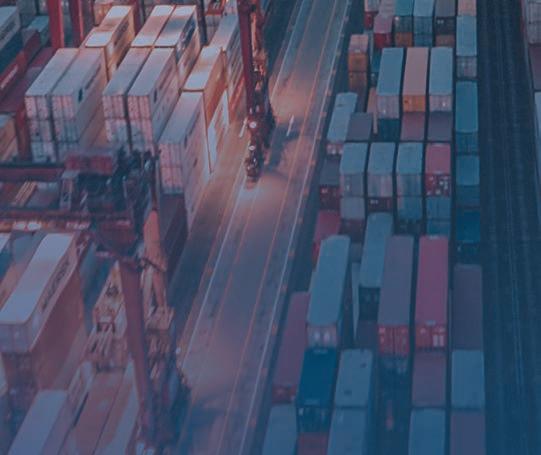




Fonterra Brands New Zealand’s (FBNZ) distribution centre, affectionately named The Shed, recently celebrated five years of operation. With SAP Extended Warehouse Management (EWM) and voice solutions, they deployed the platform to help drive operational and digital supply chain efficiency and ensure ongoing future success.
Fonterra is the world’s largest dairy exporter, with about 16 billion litres of milk processed annually. The Shed is a purpose-built greenfield site which enabled the consolidation of seven warehouses into a single multi-temperature facility. There are 15,000 pallet locations spread across three temperature-controlled environments including freezer, chilled, and ambient – and these support the despatch of approximately 60,000 cartons per day.

Customer orders comprise products including short shelf-life, perishable cultured products, through to long-life milk and cheeses and are despatched throughout New Zealand and exported to the Pacific by Fonterra’s team of 52 people who utilise RF scanners and voice technologies along with supporting wireless printing.
At the heart of its technology layer is SAP’s Extended Warehouse Management solution. The solution complemented Fonterra Brands’ vision of having a single distribution centre to serve New Zealand and the world with its top line dairy products.
The solution has become pivotal in automating workflows and simplifying and optimising Fonterra’s digital supply chain. It is instrumental in directing all operations from task management to end users, to inventory management and accuracy.



With a fragmented supply chain, Fonterra needed to bring its technologies together to help drive supply chain efficiency.
The organisation’s digital supply chain
“
“Our Inventory Record Accuracy is 99.7 per cent,” says Brent Fiecken – GM Logistics & Distribution Fonterra Brands.
required full traceability from manufacturer to customer, and with so many variations, product mixes, distribution routes and routes to market, they needed one solution to allow them to leverage all of these. SAP’s EWM solution was selected as the platform to help drive both efficiency and accuracy.
For Fonterra Brands, quality and freshness are also critical areas where there can be no compromise. With sampling requirements and customer specific shelflife requirements, the processes needed to support the complete traceability of batch and lifecycle information. The company implemented the voice picking solution in warehouse pick face areas along with RF scanners so that production and efficiency would be not compromised.
By introducing the voice picking solution, the warehouse team are automatically directed to the right products, at the right location to help meet their customers’ demands. In addition, the scanning and voice confirmation ensures the highest level of compliance.
Full transparency is provided via the out of the box integration between the SAP ERP and WMS to ensure both food safety and traceability is enabled beyond the warehouse operations.
While operational performance is now best in class, history has shown that there is a lot of work required in getting processes and technologies aligned to ensure the team are set up for success. At Fonterra Brands, voice had been trialled prior to the implementation of the EWM solution
““The deployment of SAP’s Extended Warehouse Management has been a key enabler for us to help bring all our technologies together including the voice picking solution and RF scanners. It has enabled us to be as effective as we are today,” says Brent Fiecken – GM Logistics & Distribution Fonterra Brands.

”
but without success. By implementing EWM, Fonterra Brands added efficiency and accuracy to the day-to-day operations including a whole new level of productivity that helped make the working lives of the team easier.
“The benefit for us from a safety point of view, is that our team members have the use of both hands as they walk through the pick phase and pick cartons. This not only allows them to concentrate on counting and getting the accuracy correct, but also focus on proper handling techniques,” says Walter Pswarayi – Distribution Centre Manager, The Shed
At Fonterra, safety is at the core of what we do, and voice was just going to be that additional part that would help deliver that safety and efficiency. As a result, we now have the capability to pick and deliver quite a significant amount of volume.”

SAP and Fonterra have had a long-term partnership spanning over 20 years.
“SAP is proud to have The Shed as one of its lighthouse reference sites in New Zealand and across the region,” highlights Adam Peanna, SAP Digital Supply Chain Centre of Excellence APJ.

Whenever I have been onsite, I have seen first-hand how the team has embraced the technology to help drive efficiency and safety.”
Scan the QR code below for more information on our Digital Supply Chain solutions.
By introducing the voice picking solution, the warehouse team are automatically directed to the right products, at the right location to help meet their customers’ demands.






CBRE’s Jason Burgess and Christine Miller discuss the increasing importance of changing fit-outs to get more throughput with the same property footprint – and the challenges and opportunities of funding such transformations.
The rise of e-commerce over the last few years, combined with consumer demand for fast delivery, has placed increased pressure on landlords and occupiers to futureproof their assets.
One way occupiers and landlords are looking to do this is by investing in new fit-outs and automation, say CBRE’s Jason Burgess, Senior Director of Debt & Structured Finance, and Christine Miller, Head of Supply Chain Advisory.
New fit-outs including automation and technology solutions can require significant CAPEX. So, what opportunities exist when it comes to funding your industrial and logistics asset and ensuring your supply chain is prepared for the future?

Jason Burgess heads the Victorian Debt & Structured Finance business for CBRE, and has deep experience
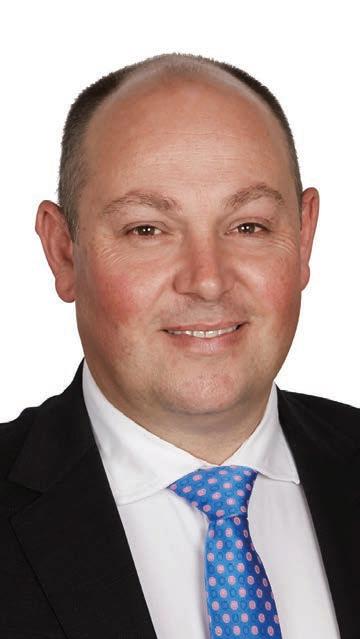 Jason Burgess, Senior Director –Capital Markets – Debt & Structured Finance, CBRE.
Jason Burgess, Senior Director –Capital Markets – Debt & Structured Finance, CBRE.
in this area. “We currently manage a significant amount of invested capital,” Jason says, “with funds largely coming through direct relationships with offshore lenders. It’s a growing and increasingly important part of CBRE’s business –even though it’s not the first thing that might spring to mind when you hear the name ‘CBRE’.” He says that CBRE has connections with many funds, and his team deals not only with traditional mortgages, but also equipment financing, fit-out financing, and business-tobusiness lending.
“While most of our day-to-day work involves property lending, we do other types of lending as and when our clients need it,” he says. “Typically, we look at proposals ranging from $5 million to $300 million; that’s where we do a lot of our work.
“There’s a wide variety of things that come through our pipelines, whether it be equipment finance – planes, trains, automobiles, fitouts, computers, and anything else a business needs to operate properly. This is a growing and dynamic area, so we will help our clients in whatever way we can.”
Jason notes that we are coming out of a couple of years through the pandemic where interest rates were at all-time lows.
“People are talking about interest rates going back up now – and that’s sometimes said to create a negative sentiment in the market,” he says. “But I don’t necessarily view it that way. It’s more back to positive business-as-usual. Inflation is threatening to get out of hand, so interest rates will naturally rise, but I think this will tail off over time.”
He says his current experience
indicates “there’s still plenty of funds out there”. Despite the headlines, it’s not all bad news in the market, and borrowers shouldn’t be unduly discouraged. “It’s not all doom and gloom. Banks and non-banks are still very keen to write business.”
Jason points out that, significantly, the interest rates set by the Reserve Bank of Australia are rising, but the marginal rates on top of that – by those doing the lending – aren’t increasing much.
“In some cases, they’re coming backwards,” he says. “So, while I expect central bank interest rates to keep rising for a while, there’s still a lot of appetite in the lending market.”
Because Australia is regarded as a relatively safe place for international lenders, banks and funds are very active and becoming more prevalent every day.
“There is a strong willingness from lenders to provide finance, even if there are a few more boxes for lenders to check off than there might have been a few years ago.”
Christine Miller, who leads CBRE’s team of supply chain practitioners, says that getting funding for supply chain and warehousing transformation is often the last and most challenging hurdle, particularly after the disruptions to supply chains as a result of the pandemic.
“What we’re seeing now is businesses having to re-assess postCOVID what their growth looks like,” Christine says. “How does their growth normalise over the coming months and years, and what are the best strategies for ensuring it does?”
With a tight industrial property market – highlighted by historic low vacancy rates in the industrial and logistics space – she says many companies need to increase throughput within their existing warehouse footprint.
“This means getting more out of existing operational sites, which often requires investment in improved fit-out – improved process handling equipment,” she says. “Those transformation decisions are often made at the board level. One problem supply chain and logistics business units sometimes face is that there isn’t a direct line of sight between those operational investments and a company’s consideration of its top-line growth. That’s why the final stage – the sign-off to get funding – can sometimes be difficult.”

Christine says that boards are becoming more concerned with their supply chain, but that its lack of visibility to the links between operational investments and enabling increased revenue and reduced costs means it’s easy to not pay sufficient attention to the competitive advantages it can bring.

“For many businesses, it’s actually their service delivery which is their competitive advantage,” she says.
For those already doing it well, there is no incentive to share best industry practices with their competitors. “This means everyone is trying to solve their distribution strategies independently.”
She notes that Australia – because of its relative distance from the rest of the world, and large geography with a sparse population – has traditionally lagged other mature economies in terms of
There’s a wide variety of things that come through our pipelines, whether it be equipment finance – planes, trains, automobiles, fitouts, computers, and anything else a business needs to operate properly. This is a growing and dynamic area, so we will help our clients in whatever way we can.
”
distribution innovation.
“Take multistorey warehousing as an example,” she begins. “While it might be envisioned as part of a future solution in Australia, it hasn’t been done much before. And there is a natural reluctance to be the first or an early mover if you’re adopting something that isn’t already mainstream. That’s an added challenge.”
It’s a challenge that Christine, Jason, and the entire CBRE team are working on – educating clients, be it landlords or occupiers – on the business opportunities inherent in transforming existing assets to future-proof their supply chains. Situated as their teams are within the broader business of CBRE, they are well positioned to use their industry insights and analytics to help clients make their case internally - and give supply chain units the best shot at, for instance, changing a fit-out to get the most from an existing property footprint.
“Christine is the supply chain expert and understands the intricacies of working with businesses to assess their distribution challenges and what they need to do to meet them,” Jason says. “My job is to ask, ‘How do we fund these necessary or prudent changes?’
“There are a number of ways we can fund fit-outs. The first and most obvious is to increase the debt on the property through the finance chain. If that isn’t available, our usual fallback is to do equipment financing.
“How that works is if you buy something for, say, $5 million, we’ll secure the $5 million of funding with it being paid for with a small increase on the property lease – or the lease is increased to amortise that extra finance cost over the term.”
Every case is unique, Jason and Christine agree, and it’s a matter of serving both the interests of the occupier and the landlord. But a happy, productive, and consistent occupier that has future-proofed their business through the appropriate fit-out is also precisely the kind of tenant landlords want to have.
For CBRE, it’s not an either/or benefit for the occupier or the landlord. At all times, but especially during what might seem a precarious time for supply chain and logistics properties, CBRE has its sights on facilitating industrial property lending arrangements that are a win-win for occupiers and landlords – as well as a sound investment for investors at home and abroad.

You’ve got more to worry about than the cleanliness of your facility floors – such as achieving your productivity targets. And that can be a difficult feat in a world where delays in business have become the new normal. At Conquest, we’re challenging the new normal so you don’t have to wait. We’ve invested in ensuring our range of floor cleaning equipment is readily available to buy, rent or hire without delay.
Once you have the right equipment, you won’t want to run the risk of machine downtime impacting your ability to deliver. We’re behind you all the way, with a proven track-record of resolving service requests within just 24 hours average, thanks to our national fleet of mobile service vehicles and increased supply of locally held spare parts.


Last mile logistics as the penultimate step in the supply chain can either make or break a customer’s online shopping experience. Argon & Co. helps businesses foolproof the e-commerce component of their services with intelligent solutions. James Lee, Associate Partner at the technology company discusses its advanced operations, including enabling systems such as FMS and OMS, and what the future of delivery services will look like by the end of the decade.
Technology is revolutionising last mile logistics at an important time when e-commerce is booming. Last mile is the final leg of the supply chain where a product is delivered either from business to business or from business to customer, and consumers these days expect their orders to be brought to them within a short timeframe.
Argon & Co. is improving this last step in the process by transforming client operations with intelligent solutions.
James Lee, Associate Partner at Argon & Co., says their role in supporting clients in this space also extends to ensuring they have the optimal physical network and delivery assets to meet the end customers’ expectations – a combination of speed, cost, and reliability.
Having the right network is a critical first step. “We typically start by ensuring our clients have the requisite
physical network to meet their customers’ needs,” James explains.
“While e-commerce fulfilment activities have traditionally been embedded within many organisations’ distribution centre networks, we are now increasingly seeing the emergence of standalone operations. As part of this, proximity to end customers is now a fundamental consideration.”
Argon & Co. is increasingly digitalising the network design process, with the use of digital twin technology to speed up scenario design and analytics.
“The added benefit for our clients is that they can subsequently use these network digital twins to further optimise their network flows, through tactical network scenario planning, or more effectively manage risks through business contingency planning,” he adds.
The criticality of integrated systems for efficient route orders through to end-customer deliveries has never
been more important.
“Traditionally freight management systems (FMS) have been the key to last mile optimisation, whether that being basic carrier management or more advanced route optimisation functionality,” James explains.
“However, with the push towards decentralisation networks, so inventory can be positioned closer to the end customer, order management systems are now the real brain driving fast and efficient last mile deliveries.”
The Order Management System (OMS) involves managing inventory and delivery. It’s fundamental to allocating customer orders to inventory that is closest to the end customer to minimise lead time, as well as lower delivery costs.

James notes that this does not mean the role of FMS has been diminished.
“Off the back of COVID-driven disruptions across our domestic freight network, the traditional model of having a single strategic carrier partner to manage your last mile logistics no longer works.





Reto Fuhrer is a supply chain advisor whose career and expertise span years, continents, and industries. Realising that what Australian supply chain business units most often lacked was a plan, last year he founded a boutique consulting firm to help local companies successfully navigate towards future success.
With myriad supply chain pressures and cost increases squeezing Australian companies’ finances, proper planning is more important than ever before.

“
The primary area where many Australian companies can improve their supply chain is in planning,” says Reto Fuhrer, CEO of RF Supply Chain Expertise (RFSCE), a boutique consultancy he runs, bringing years of experience from across the globe to bear on tackling today’s supply chain challenges.
Originally from Switzerland, Reto has worked in executive roles in supply chain management, operations, and general management. Among other things, his resume highlights work in the food and beverage, sporting goods, chemicals, and plastic manufacturing industries – as well as work advising the ACT Government. In addition to his background in Switzerland (he moved to Australia nearly five years ago), he has worked across the European Continent, as well as Asia, North America, and now Australia – the last of which he now proudly calls home.
By now well-versed in Australian supply chain challenges, last year he
struck out on his own in founding RFSCE. He has the rare virtue of having been both an insider and an outsider. Having worked internally and externally (as an advisor) across industries, continents, companies, and governments – his varied knowledge, experience, and expertise afford him a perspective few others can ever hope to have.
With his eye ever on the big picture, in pursuing his consulting activities Reto starts with a simple drawing he contrived that he calls the ‘RFSCE Hub’, a diagram that encapsulates elegantly all the major facets of supply chain management, and how they interrelate.
If you plan to build a house, it helps to draw a blueprint. Planning is everything.
“When I talk about supply chain management, I conceive of it as a house sitting in a row of additional houses,” Reto says. “You always have neighbours – customers, suppliers –but internally the house is upheld by
four main pillars: the planning pillar, the procurement pillar, the operations pillar, and the distribution pillar.”
Sitting atop these pillars, Reto says – giving shape and purpose to the structure – is the roof, whose layers comprise supply chain strategy, personnel management, and change management.
“Finally, the house is standing on several different support functions,” he says. “These support the whole house – or business – in its success and resilience. For our horizontal support beams, we have warehouse management, material management, foreign trade and customs management, digitalisation, HSEQ components, and supply chain controlling.”
This visual technique is a helpful way of understanding the interrelation and relative importance of various supply chain components. Ultimately, all of them fit together to create a sturdy supply chain structure. And – like any
good building planner – Reto sees all the pillars, beams, and materials at once; as well as where to go to get them.
“Working from the idea of the Hub, RFSCE has developed an ecosystem of partners – individuals and companies – that can support us in providing the things we need to execute on a holistic strategy that we conceive,” he says. “At RFSCE we devise careful plans to optimise supply chain outcomes, and then tap into our network of contractors and partners to come in and help us make that plan a reality.”
While technology agnostic, Reto is emphatic about the importance of using new technologies to gather historical and contemporary data for understanding companies’ unique supply chains. “If you are planning where to go, it helps to know where you’ve come from,” he says.
“Many Australian businesses, particularly SMEs, don’t use very sophisticated data management techniques and technologies – and yet accurate data is high value, lowhanging fruit that all planners should be picking.”
Take, for example, inventory management – an important yet often improperly managed part of supply chain planning.
“Accurate data and data-analytics are essential to optimising inventory levels,” Reto says. “And of course, positive outcomes in inventory management support positive outcomes in other areas: customer service is improved because you deliver what you promised when you promised it; there’s also a positive effect on cash flow, because expenditures are better timed, and money isn’t wasted.”
Industry talk about moving from a ‘just-in-time’ to a ‘just-in-case’ inventory model in wake of COVID can trick businesses into a misleadingly binary way of thinking, he says.
“I’ve heard many accounts from colleagues of businesses that went full 180 degrees after the onset of the pandemic – from ordering just what they needed, when the going was good and things were flowing easily through the supply chain, to suddenly filling their warehouses with materials in
case supply lines were cut off. This has resulted in companies shifting from having inventory problems to having cash-flow problems. There’s a balance that needs to be struck, here.”
But how does one strike that balance? In short, says Reto: good planning, good data, good technologies, and good relationships – both with suppliers and customers.
He notes that recent studies have demonstrated that with optimal sales and operations planning processes in place, and supported by modern technology, radical improvements are possible. Reto cites the following figures illustrating improvement potential:
• Forecast accuracy improved by 20 to 50 per cent;
• Inventory reductions of 20 per cent;
• Production time savings of five to 15 per cent;
• Storage costs decreased by 1o to 30 per cent;
• Five to 10 per cent improvements in delivery time;
• Revenue increases of up to 25 per cent; and
• Operating margins improved by 20-plus per cent.
“For successful long-term decision making in an increasingly complex and fast-paced world, companies must harness the best people and processes in concert with the best modern technology for purpose,” Reto says. “This doesn’t mean the most expensive technology, but it means moving beyond Excel, and out-ofdate or inconsistent data sets, as the basis of decision making. Businesses must use a platform where everyone involved can make decisions working off the same, accurate, data.”
Where many businesses misfire in adopting new technologies and techniques, says Reto, is that solutions are purchased or implemented in isolation, without full understanding of their implications, and without full buy-in from all company stakeholders.

“Full success only comes from an integrated solution, and interdisciplinary teamwork is key to achieving that,” he says.
“Technology implementation and ‘optimisation’ is sometimes misconceived as only for large companies, and only affordable to large
companies. This isn’t so. At RFSCE we are experienced in working with SMEs and can plan and execute affordable technology implementations that will make a big difference – no matter how large or small your business is.”
With myriad supply chain pressures and cost increases squeezing Australian companies’ finances, the future might seem difficult to navigate.
“That’s why companies need a plan – and that’s where we come in. It’s often hard, internally, to see how everything fits together and devise a plan that will get you where you need to go.
“At RFSCE we can bring that outsider’s perspective, grounded in years of insider experience across industries and continents. We find that when we start talking to and working with clients around planning processes, many seemingly unrelated issues automatically disappear.
“To any business in need of a true plan-driven, outcomes-oriented supply chain consultancy, I say ‘Give us a call’. We offer a free initial 30-minute exploratory conversation – so there’s nothing to lose, and potentially a lot to gain.”
■
To find out more, visit www.rfsce.com
Conquest Equipment, renowned for its reliability and customer service as a vendor of manual industrial cleaning equipment, has just announced its first exciting foray into the realm of robotic automated cleaning. MHD finds out more.
Conquest Equipment is now a partner of Avidbots selling Neo, the fully autonomous cleaning robot, to the industrial sector across Australia.

Conquest Equipment has long been the Australian leader when it comes to selling and renting out manual industrial cleaning equipment. With a network of personnel stretching across Australia, Conquest’s calling card is its service, reliability, and depth of expertise –regardless of where their clients are located.
But Conquest didn’t become a household name by resting on its laurels.
Ben Mathews, Sales Director at Conquest, says it is a ceaseless desire to improve its offering and service that has led to what is a new breakthrough announcement – Conquest’s first move into the automated cleaning
“The past five years we’ve seen a real change in automated cleaning technology,” Ben says. “There’s been a lot of tests, some successes, and some failures in the automated cleaning space by a variety of companies. At Conquest, we weren’t about to jump the gun and offer automated cleaning machines until we were absolutely confident in them – because trustworthiness and reliability is what we’re about.”
“But, we’re happy to announce that we have formalised a partnership with one of the world’s leading robotics companies, Avidbots, based in Kitchener-Waterloo, Canada. With this partnership we are a Neo vendor
in Australia focusing on the industrial sector.”
This arrangement will see Conquest sell, rent, and service Avidbots’ robot Neo exclusively in the Australian industrial cleaning sector. Being a dealer of the Neo, a fully autonomous robotic floor cleaner incorporating best-in-class AI and machinelearning, is a real coup for Conquest as it makes its first move into the automation field.
From Avidbots’ perspective, they’re excited to expand their reach across Australia and leverage the depth, breadth, and sophistication of Conquest’s nation-wide network, personnel, and sales and service infrastructure.
“Neo powered by Avidbots Autonomy is the most intelligent robot on the market right now that delivers a consistent, efficient and measurable clean,” says Ben. “With its AI technology delivering realtime obstacle avoidance and dynamic path planning as it works, it sets itself apart from competitors in the marketplace – which are mostly predicated on a teach and repeat concept. It’s truly an autonomous robot in a way that others aren’t.”
The partnership made sense for both Conquest and Avidbots. A perfect meeting between new world-leading technology and a company well established with a reputation for excellence.
“On our side, the key reason for the partnership is that we will often go into a warehouse and the client will need a sweeping machine and a scrubber – so we offer those products or services as a joint package,” he says. “For Avidbots the partnership made sense because Conquest has existing relationships and a service network across Australia, and many industrial leaders that can benefit from an autonomous cleaning robot.”
“The Neo will be offered separately, for hire or purchase, or in packages alongside more traditional sweeping equipment. This means Conquest can offer the best and most comprehensive cleaning solutions in the industrial space.”
Ben says that in the cleaning space, as in so many others in supply chain and logistics, “automation is the future”.
For Conquest, it’s important to stay at the leading edge of technology –providing complete cleaning packages, but ensuring that anything it offers is tried, true, and reliable.
“We wanted to ensure we could offer a machine that was suited to the Australian industrial space – and suitable for our customers based on their feedback and our close observation over many years,” Ben says. “After exploring what autonomous solutions were available in the market, Neo was the clear winner. Built from the ground-up to be a robot that’s optimised for autonomous cleaning, it’s unmatched
compared to other solutions currently available. Neo is now in its 8th generation and has been continuously improved based on customer feedback, ensuring reliability remains at the core of the product offering.”
This latter point is crucial, Ben says, because there are lots of robotics startups that are superficially attractive but lack the support systems that have been carefully constructed alongside the Neo.
“Our good name is our capital,” he says. “We’re not going to risk selling a product that lets our customers down. With Avidbots, they have developed both the machine, software and the support systems to deliver a first-rate cleaning robot that is ideally suited to our industrial cleaning market sector.”
While Ben is excited about the Avidbots partnership and knowing that Conquest will continue to push the frontiers of automated cleaning solutions, he highlights that Conquest will continue to find the ideal cleaning solution for each client.
“Automation is key to the future of cleaning, but that doesn’t mean it can or will be able to do everything – or will be appropriate for every customer,” he says.
Conquest’s Intelligent Solutions Program (ISP) is an eight-step guided process by Conquest floor cleaning specialists that ensures customers get the best cleaning solution for their individual business circumstances.
ISP takes customers from initial on-site assessments – that assess the variables at play in each warehouse environment – all the way through to delivery of equipment and training of users.
“We take our customers on a journey to ensure they find the right cleaning process for their facility,” Ben says. “In some instances, an autonomous cleaning robot will be appropriate – in others, it may not. There are many factors to be considered to determine the best cleaning solution for each customer and their facility. To determine what solution is required to deliver the best clean in their facility we complete an objective assessment and then make a recommendation. We won’t recommend automation unless
it’s right for the customer.”
The bottom line for Conquest is the long-term bottom line of its customer.
“We help companies to assess their cleaning needs and expenditures with return-on-investment front of mind,” Ben says. “If you have a 30,000 sqm warehouse that can be cleaned sector by sector every week – and especially overnight when people are asleep –then that’s where robotic cleaning solutions will prove highly valuable.”
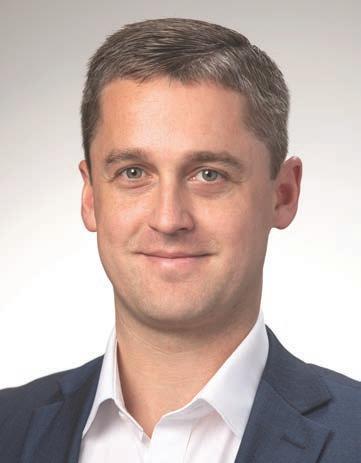
And while the Avidbots partnership is just beginning, we’re excited to see what the autonomous future holds as we work together to expand Neo’s footprint across Australia, building on the success Avidbots has already found here,” Ben says. “We’re on a journey with our trusted supply partners, offering solutions in keeping with our guiding principles of reliability, utility, cost effectiveness, safety, and service. We won’t jump the gun on any solution that doesn’t pass our rigorous testing protocols, but we certainly do hope to offer a full suite of automated cleaning solutions in the future.”
Conquest is currently upskilling its workforce until it is fluent and practised in Neo by Avidbots – and looks forward to rolling out its first cleaning robots to customers.
“Give us a call. We’ll come out and do a site evaluation and make an objective, evidence-based recommendation. Maybe you’ll be one of those sites that will really benefit from an Avidbots Neo – but even if not, we’ll still provide you the best possible solution for your needs.”
Running an outsourced supply chain requires a higher degree of coordination and alignment across all supply chain partners that only a Supply Chain Operating Network can provide.
Paul Soong, Regional Director at e2open ANZ, talks about the best methods of managing your goods offshore, and the importance of a Supply Chain Operating Network to effectively align domestic and international supply chain partners.

The global trade network has provided long term success and profitability for Australian businesses over decades. Relying on a global network of suppliers, manufacturers, and logistics providers to design, assemble and ship their products, has allowed for businesses to focus on their core competencies and gain cost benefits using specialised outsourcing partners.

Although onshoring operations has its benefits, for many businesses, maintaining relationships with global partners is paramount to business survival and success. In an environment where the ebbs and flows of global supply chain processes are unpredictable by nature, companies require better visibility to orchestrate the movement of goods with their supplier and logistics providers on and offshore.
As the number of partners in the supply chain increases, so does the level of information exchange and coordination required among all the partners. This is no simple task.
To make things even more challenging, companies across all industries are facing three trends that make running supply chains
more difficult:
1. Product proliferation: The significant rise in highly personable and customised products has presented companies with the need to exploit every single market niche and expansion into new geographies. In consumer markets, customer demand and market trends are shifting faster than ever, often driven by social media. As a result, it is not unusual for a consumer goods company to replace one-third of its products every year.
2. Shorter cycle times: Some call it the “Amazon Effect”, but expectations of super-fast service are not limited to the consumer market. Enterprise customers also expect rapid deliveries and quick order confirmations or answers to order changes.
3. High productivity pressure: As costs have been driven out of supply chains for years, there is not much “fat” left in the system. Companies now run lean operations with minimal inventories, just-intime deliveries, etc. This does not leave any margin for error or lastminute changes. As a result of this additional complexity and cycle-time compression, the need for end-toend visibility and tight coordination among supply chain partners is all
the more important.
Conventionally, companies relied upon Enterprise Resource Planning (ERP) systems to be the system of record and the process orchestrator for everything that happens within the four walls of the company. Yet, with the unpredictable external pressures that have emerged since the pandemic, more and more is happening outside the four walls of the corporation and therefore outside the scope of ERP systems.
So, how do you successfully run an outsourced supply chain, when there is data model to store and exchange information back and forth with
Expectations of super-fast service are not limited to the consumer market. Enterprise customers also expect rapid deliveries and quick order confirmations or answers to order changes.
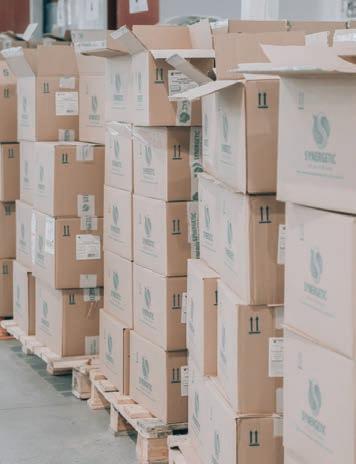
outside parties across multiple tiers of the supply chain?
Many companies recognise that to run today’s supply chains requires them to extend what ERP has done to the new reality of the multi-enterprise supply chain. A key aspect of this is the ability to respond to changes in demand and supply and integrate all up-to-date supply chain data in a complete endto-end plan.

Traditional planning systems lack fast problem resolution, scenario, and decision support capabilities to manage trade-offs and iterate through multiple alternative what-if scenarios.
Leading companies are using stateof-the-art planning applications that give them rapid decision support with what-if scenario capabilities. These tools allow planners to evaluate the impact of this new information – be it a supply disruption or an unexpected order – and easily compare alternative plans to select the best option to be shared with all impacted supply chain partners.
One example of this is connected demand planning, which requires a new level of collaboration across internal stakeholders and with channel ecosystem partners, such as retailers, distributors, resellers, and even end customers. These applications give the ability to develop an accurate forecast to help manage an efficient, effective, and sustainable supply chain organisation and can be the difference between meeting or not meeting customer expectations for service and quality.
E2open’s demand planning and sensing platform provides a modern connected approach that facilitates seamless sharing of signals and plans between all parties, unlocking value for clients and partners alike.
Reusable network connections reduce the cost of exchanging information, while purpose-built AI transforms disparate partner data into decision-grade information to get a full end-to-end picture of demand for confident decision-making, even in uncertain markets. Having been recently recognised as a Leader in IDC MarketScape Report for Worldwide Supply Chain Demand Planning, this platform is part of a holistic solution encompassing all planning needs on a single connected network platform.
On top of the need to employ demand planning and sensing platforms, a cloud-based network can help enable end-to-end visibility and collaboration among supply chain partners. Combined with dedicated decision-support applications that leverage the data in this network, this helps companies better sense and respond to changes. This is increasingly being referred to as a Supply Chain Operating Network. Different from procurement networks that act as online marketplaces, Supply Chain Operating Networks focus on direct materials and more evolved collaborative workflows related to running an outsourced supply chain.
The significant rise in highly personable and customised products has presented companies with the need to exploit every single market niche.
Early adopters who are leveraging such solutions for running their outsourced supply chains see a range of benefits:
• Shared, single version of the truth that all supply chains partners view and can act upon;
• Always up-to-date and supporting the “always-on” economy; and
• All parties can fulfill their roles and responsibilities, making their own decisions, but in full alignment with the others.
Running an outsourced supply chain requires a higher degree of coordination and alignment across all supply chain partners that only a Supply Chain Operating Network can provide. It is therefore not a surprise that companies that have been at the forefront of outsourcing are also the ones that have embraced the new demands of the modern supply chain.
■
MHD speaks with Venkatesh Ramakrishnan, Head of Maritime, Logistics and Retail, Nokia, about why 5G implementation is the cornerstone upon which Industry 4.0 successes are built.
5G is a game-changer for supply chain processes by virtue of its low latency, providing the connectivity required to operate robots in logistics spaces.
Much has been made of the rigidity and frailties of supply chains in wake of the COVID-19 pandemic, climate change challenges and geo-political disruptions. One thing that is for certain is the shift that is taking place towards more agile and responsive operations, where companies leverage Industry 4.0 digitalisation to respond faster to disruptions and gain competitive advantages.
Digital supply chains which enable real-time end-to-end transparency are making logistics operations more efficient and cost-effective by helping businesses meet their planning, pricing and delivery commitments.
Venkatesh Ramakrishnan, Head of Maritime, Logistics and Retail, Nokia
says the journey to mastering digital transformation can be hampered by overexcited use of buzzwords without proper consideration of the business impact of new technologies.
“We try to identify the main problems on the business side that the customer wants to solve, in order to look at what kind of technology can help us solve that problem,” Venkatesh says. “Then we look at the communication networking piece, in terms of what kind of communication networking setup will enable that particular technology to solve that business problem.”
Consider a warehouse, where the main business problem is that the lead time to fulfil an order is very high. To counteract this, a business manager might make

the decision to invest in robots from a vendor to reduce these lead times.
Venkatesh explains that businesses get stuck when they realise that WiFi doesn’t provide the reliable low latency connectivity required for the operations of the robots. While Wi-Fi is a suitable technology to support IT operations and certain non-critical workflows in the warehouse, a 4G or 5G mobile network offers the bandwidth, speed and reliability most smart warehouse applications require.
“Then the business owner or the IT owner realise they need to investigate either a 4G or 5G network solution to help the robots to always perform at their best,” he says. “This can be true for not just robots, but also for sensors,
drones, video cameras, optical image recognition et cetera. Ideally, the Chief Information Officer (CIO) can identify all the business needs, then map them to all the technological innovations that can be made and then map that to all the network infrastructure that they need.”
WiFi requires a lot of access points because it has a relatively short coverage radius – and so therefore mobility on the warehouse floor becomes a challenge, just as it would were a user jumping from one WiFi connection to another with their mobile phone rather than being connected all the time to a 5G network.
Venkatesh notes that 5G is a gamechanger for supply chain processes by virtue of its “low latency” – minimal delay processing and communicating data between points in a network system – and its “robustness” compared with competing alternatives.
He elaborates on the differences between 4G and 5G within the supply chain context.
“There are two dimensions to consider – the first is the maturity of the supply chain company which is interested in deploying a mobile technology, the second is the regulatory compliance of what is available in a particular country,” he says.
“The supply chain industry is moving faster on the Industry 4.0 mandate, but it is still not completely there yet. 4G is able to fulfil a lot of requirements in the short term. Now, and certainly in the future, 5G will make a really big impact because of its ultra-low latency. 5G can offer you latency of five to 10 milliseconds compared to around 30 to 40 milliseconds on 4G LTE (Long-Term Evolution). Robots will require this ultralow latency for faster communication.
“The second point is the regulatory requirements. Countries like Germany, Sweden, Denmark, France, Italy, South Korea, Japan and the UK – these countries have already started issuing enterprise license spectrum for 5G frequency – it is something that you need to activate a 5G or a 4G private wireless network. In these countries, you can simply very easily deploy a private wireless network and it will fulfil both the technical requirements of LTE but also go one step further and give the 5G power. The best that companies can do outside of these countries is to apply for
a 4G license, where they can upgrade to 5G later on.”
E-commerce giant Alibaba works with Nokia to stay ahead of the curve and digitally transform the logistics industry. It’s just one example of Nokia providing networking solutions for the new industrial era, where smart warehousing takes predictive maintenance as well as picking, sorting and fulfillment to new levels.

In Australia, 4G private wireless network deployments in industries like mining are already making a big impact – and this will only accelerate across other industries once the government issues a 5G spectrum at the end of this year or early next year.
“If you are operating a warehouse near an airport or if you are an air cargo company, for example, what you’ll be able to do is buy the solution from telecommunication companies like Nokia and apply for a 5G spectrum from the government,” Venkatesh says. “This will provide businesses with their own private 5G network, fulfilling all the Industry 4.0 use cases.
“From an industry point of view, Australia is really interesting. Because Australia is so big, a lot of our warehouses are very large and need to have automation sooner or later because of the labour shortage in this industry. The monotonous tasks around the warehouse are being replaced by robots; the pandemic has sped up the adoption of the 5G digitalisation as a concept.”
To gain access to massive new computing power, 78 per cent of supply
chain executives say they are planning to partner with other companies in the next three years, and 57 per cent plan to invest in technology or startups. Nokia’s Bell Labs Consulting found that safety, productivity and efficiency improve elevenfold for manufacturing, ninefold for logistics, sixfold for agriculture and fivefold for mining when shifting to 5G technology. In a recently conducted EY survey of 2000 global CEOs, ‘investing in digital transformation’ was named the second most important capital strategy (20 per cent), and investment in sustainability the third (13 per cent), for which digital technologies are a key driver.
“Australia is a strategic location for us,” Venkatesh says. “One of our projects with one of the big ports in Australia dealt with many containers, vessels and metals moving around. Their WiFi network wasn’t reliable at times, so we helped to create a reliable infrastructure solution for all the ongoing digitalisation projects.
“The main requirement was wide coverage, reliable connectivity, low latency, and high bandwidth. Now, the customer is mounting multiple use cases: the planes are able to get all the job information on what they need to do, all the IoT devices are connected to the same network, the video traffic is connected as well. Once you place a private LTE or 5G network, it’s an infrastructure investment which has a huge capacity. You can keep adding more use cases which improves the business case for the investment even more.”
The Women in Industry Awards were held on Thursday September 8 at Sydney’s Doltone House with a gala dinner. This event was all about celebrating and recognising women’s achievements across a range of industries –including supply chain and logistics.

is a key part of the Executive Leadership Team.
Women in Industry Awards.
The Women in Industry Awards – sponsored by Weir Minerals, Komatsu, and Atlas Copco –on September 8 at Sydney’s Doltone House, Jones Bay Wharf recognised accomplishments in mining, engineering, manufacturing, and more.
Fulton Hogan’s Sarah Marshall won the much-coveted Woman of the Year Award with Biljana (Billie) Stanic from Martinus and Emma Muller from Horizon United Groups as runners-up.
The finalists and winners were for both the years 2020 and 2021 (when the ceremony couldn’t be held due to COVID-related lockdowns).
Sarah won awards in Excellence in Construction and Woman of the Year. She is a Construction and Infrastructure Executive with extensive experience in leading the operational functions of People & Culture, Industrial Relations, Safety, Marketing & Communications and Environment, Community &
Sustainability. She has spent her professional career spearheading positive change in the construction sector. This includes driving infrastructure sustainability, improving the culture, reducing the stigma of mental health issues, and more. Sarah is also a board and director member, executive sponsor, co and deputy chair, and chair of several organisations and associations.
Sage won the Business Development Manager of the Year Award. She is the VIC State Manager for Bio Gro, a family-owned business that produces quality products from Organics and is at the forefront of the circular economy, diverting more than 500,000 tonnes of organic material from landfill each year. She has been with Bio Gro for the last 10 years where she initially started in the operations as a weighbridge operator and has progressed through various roles in the company to where she today
Louise won the Excellence in Engineering Award. As Aurecon’s Group Chief Operating Officer and former CEO for Australia & New Zealand, she is one of Australia’s highest profile female engineers. With more than 20 years’ experience as a Chartered Civil Engineer, Louise became the first female Executive Director on Aurecon’s Board in 2013. Under her leadership, which focused on inclusion and wellbeing, Aurecon continued to grow and deliver outstanding financial results during the turbulence of the pandemic. Her track record as a well-respected, empathetic, and effective leader makes her a valued keynote speaker at engineering industry conferences. Louise is a passionate advocate for female leadership and equality within STEM.
Rebecca won the Excellence in Manufacturing Award. Boxhead Plastics is an Australian owned not-for-profit Social Enterprise. It exists to support the automotive industry divert more of its plastic waste from landfill. It has pioneered an innovative process that successfully repurposes polypropylene car bumper bars into clever, useful, and relevant products from Australia’s growing pile of automotive plastic waste. From a 15-year government administration job, Rebecca retrained as a Polymer Technician and pioneered an innovative process that successfully repurposes plastic waste car bumper
bars into golf tees and coasters. Boxhead Plastics plays a critical role in the remanufacturing of one specific plastic waste stream, post-consumer automotive plastic car bumper bars.
Sarah won the Excellence in Mining (sponsored by Weir) Award. She is the Chief Executive Officer of idoba, a new digital transformation service business for the mining industry and beyond. She is an experienced mining and management consulting executive with an impressive background spanning operations, improvement, innovation, technology, and asset management. She has worked with a wide range of top tier organisations across industries of mining, oil and gas, manufacturing, and healthcare. Sarah founded ImpRes (Improvement Resources) in 2010, specialising in business improvement for the resources sector, and in 2012, formed her second company Sandpit Innovation, to specialise in developing leading edge technology and innovation solutions for the mining sector.
Frances won the Excellence in Transport Award. Frances Ross founded Ross Transport in 1975 with her late ex-husband Reg. She took over the business in 1989 with her son Alan and has always been at the helm steering an extremely successful business doing all jobs within the company operations. Still involved in the business today, Frances oversees office staff while training her granddaughter to take over the family business. She has always been heavily involved in the business even now at the ripe age of 81 and has taken part in the i98fm Illawarra Convoy since 2005 helping raise more than $15million for the local community and has donated almost $915,000 on behalf of the Ross Transport family until 2021.
Nina won the Industry Advocacy Award. She is Regional Communications and Stakeholder Manager at Fulton Hogan in Victoria with extensive experience in leading stakeholder management, business and community engagement, and marketing and corporate communications. Serving a purpose

greater than herself, Nina is passionate about breaking down barriers for women by addressing bias and identifying opportunities for greater female participation in the construction industry. She led the development of the first women’s white night-time PPE on the Australian market and was a key conduit in building partnerships between Fulton Hogan, AFLW and amateur football club’s – which has resulted in flexible employment pathways for the clubs female players.
DANIELLE BULL
Danielle won the Mentor of the Year Award. Always looking for new avenues to promote success for women, she is driven to foster positive environments, not just at WesTrac but across the industry. Her proactive style, as well as the role she holds at WesTrac as General Manager of Operations leading a team of more than 1300 people, give her huge influence to inspire women and men to challenge their preconceptions of what it takes to succeed in the mining and construction industry. A role model of the highest degree.
Helen won the Rising Star of the Year (sponsored by Atlas Copco) Award. She is a Validation Specialist in the Analytical Science and Technology function at Seqirus, the vaccinemanufacturing business of global biotechnology company CSL. Helen has demonstrated a passion for achieving excellence in her work across the entire Seqirus product portfolio, which includes the locally manufactured Influenza vaccine, Q Fever vaccine, Australian antivenom products, and the AstraZeneca COVID-19 vaccine in
response to the coronavirus pandemic.
She was pivotal in creating frameworks that enabled Seqirus to nimbly adapt their manufacturing process to produce the AstraZeneca COVID-19 vaccine.
Barbara won the Safety Advocacy Award. She has been with Fulton Hogan in Safety roles since 2016 and has over 11 years of experience in the civil construction industry. She currently manages a large Safety team that is committed to protecting the safety of staff and contractors, whilst working to promote and maintain the strong safety culture at Fulton Hogan, making the workplace a safe environment for all. Working closely with her team, Barbara created the Stay Safe Not Silent safety campaign, a three-video campaign that has made an enormous impact across the business.
Joanne won the Social Leader of the Year (sponsored by Komatsu) Award. She has quickly built the trust and respect of the community, through her authentic engagement approach, and passion for kickstarting and developing the careers of underrepresented groups in the construction industry. During her time with Fulton Hogan, Jo has championed multiple strategies to develop and deliver best practice processes in diversity and inclusion, social procurement, Aboriginal workforce participation, workforce development and community engagement. Jo’s professional purpose is to use her industry and community connections to change lives, by creating genuine opportunities for people to thrive.
MEGATRANS returned after a COVID-induced hiatus, and it was bigger and bolder than ever. The MHD team attended panel discussions, conferences, keynotes, spoke to exhibitors, and covered the Victorian Government Ministerial Breakfast and the Mercury Awards. Exhibitors showcased their services, solutions, networked, and spoke about what they aimed to gain from participating in the three-day-long event.
For the first time since 2018, MEGATRANS, the largest logistics exhibition in Australia was held at the Melbourne Convention and Exhibition Centre from Wednesday August 24 to Friday August 26.
The three-day-long event featured a ministerial breakfast, panel discussions, keynotes, conferences, and the Mercury Awards. All of this was thanks to Prime Creative Media’s partners and sponsors along with its titles, MHD Supply Chain News and Solutions, and Australian Bulk Handling Review.
More than 120 exhibitors from across industry, including supply chain, logistics, materials handling, and industrial property showcased their services and products while networking and building brand awareness.

The key themes for the event were: Day One: Re-Imagining the Global Supply Chain; Day Two: The Rise of E-commerce; and Day Three: Sustainability and Safety in Supply Chain.
DAY ONE
Government and industry figures spoke at the Victorian Government Ministerial Breakfast while Peter Anderson, VTA CEO and Melissa Horne, Minister for Port and Freight, gave speeches.
Peter said the Victorian government should be thanked for investing in freight, transport, supply chain and logistics, particularly throughout the ongoing COVID-19 pandemic. He added that the industry had needed to become more productive and effective due to the crisis.
Melissa read her address to the audience, in which she acknowledged the pandemic’s effect on industry. She said it was able to adapt and still provide services and items to businesses and customers.
Attendees heard My Therese Blank, Head of Oceania Market, Regional Ocean Management – Maersk, Shaun Mooney, Executive General Manager –Port of Melbourne, and David Irvine, Chief Executive – Siecap, speak during The Global Supply Chain Challenges
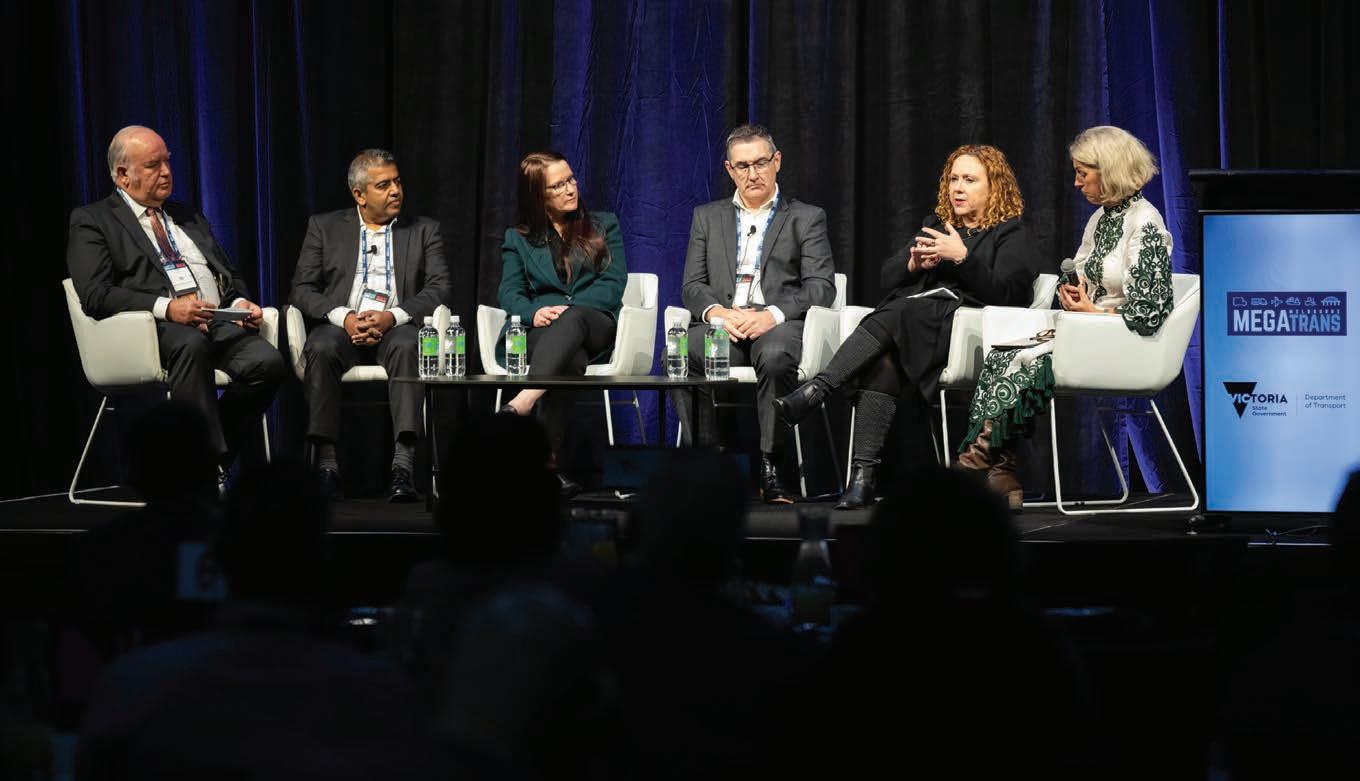
panel discussion.
Besides stock and labour shortages, as well as COVID-induced congestion at ports globally and freight rates increasing dramatically, the three
speakers said industry will continue to operate in a fast-paced changing environment and resort to sustainable technologies such as alternative fuels.
“Green methanol will be used as an alternative fuel for shipping,” My said. “The only problem is nobody is producing green methanol in Australia or New Zealand. Maersk will be carbon neutral by 2040.”
Other sustainable technologies the three said industry will adopt are batteries and liquid hydrogen. Companies chose to exhibit their wares at MEGATRANS for several reasons.
“Primarily, we’re trying to keep up the exposure of the Microlistics brand,” Michael Weir, Managing Director at Microlistics, said. “Let people be aware of the good work we’re doing to improve our product and see if there’s anyone who needs some help with warehousing solutions.”

Chris Littlewood, Country Manager at Combilift said the materials handling company was building awareness of its brand, products, and to display its various solutions for industry. “It’s great to reconnect with a lot of our customers. Many of them are passing by to see what’s new.”
“We would like to build our database in the transport and logistics industry,” a Conquest Equipment representative explained. “Our biggest market is in this industry. We’re offering our whole range of
floor sweepers and scrubbers. We have a solution for every industry.”
One of the conference panels was Improving the Supply Chain to Deliver Solutions. Stephen Lakey, Director of the Supply Chain and Logistics Association of Australia was moderator.

He led the conversation with Gerry Cleary, Director, Solution Consulting – e2open, and Pas Tomasiello, Senior Regional Director – Dematic, as well as two MT Data representatives.
“In the supply chain business, it’s about doing well today but better tomorrow,” Pas said. “Dematic is about agility, resilience, and flexibility. We help businesses implement automation and technology in the distribution centres. With labour shortages being common, automation’s role is to reduce the need to rely on labour and to future-proof a business.”
MT Data representatives said its role is to connect and digitise the industry. “Truck drivers were anti-technology. We helped them realise why it’s necessary to track their movements on the road with real-time information and this is where IoT is a game changer.”
Security, driving optimisation and values along with using 5G capabilities are essential in warehouses and DCs, the MT Data representatives noted. “It provides a competitive advantage to business.”
The subsidiary of Telstra said it helps businesses use mobile devices with 4G and 5G capabilities to stay connected, especially in times when their communication services might stop working.
“From a technical point of view, we’re at MEGATRANS to talk to people through our product suite from customer-facing back to the supply chain and everything in between, and to give them an overview of our applications,” Gerry from e2open, said.
“We’re looking to position and formally launch the co-branding of the partnership,” Sean Mitchell from Argon & Co. said about the company’s joint efforts with Colliers.
“We originally launched during COVID and haven’t had a chance to get out and meet everyone.” Argon & Co. demonstrated its end-to-end capability, which included a scheduling tool and virtual reality set.
Damon, intelligent logistics system and technology company, said MEGATRANS allowed it to let attendees know what it had to offer, from conveying to sorting automation
through to automatic storage and retrieval equipment.
Rhett Talley, Marketing Manager and BDM at Diverseco said it was an opportunity for the weighing technology company to demonstrate its range of measurement and automation solutions.
One of the keynotes was decarbonising shipping, which looked at Australia’s supply of renewable energy with the country suited to developing green hydrogen – the basis of alternative fuels – due to it having an abundance of sun, wind, and land.
Panel sessions and case studies were focused on the future of supply chain and targets for 2050.
Raymond Hassall, Executive Director, Statutory Compliance at the National Heavy Vehicle Regulator (NHVR) spoke about risk-based regulatory innovation in the heavy vehicle sector.
During this keynote, he addressed heavy vehicle safety and minimising risks for workers on the roads.
The NHVR uses strategic context, technological innovation, data-driven processes, the Road Monitoring Tool, the Real Time Alert Engine, as well as fixed cameras and drones to improve
MEGATRANS made its much-anticipated return after a COVID-induced hiatus.
heavy vehicle operations.
“We’ve cooperated with Griffith University to analyse truck drivers’ sleeping patterns, disruptions and those who have sleep apnoea,” Raymond said. “This is part of adhering to the Chain of Responsibility.”
The department’s National Regulatory Model Principles include using data and intelligence to better target compliance and enforcement activity, consistent regulatory experience, reduced regulatory burden for compliant/safe operators, and more.
Adam Welch, Practice Manager from Bestrane said the logistics-problem solver had used MEGATRANS to promote brand awareness.
“It’s about reconnecting with the market and potentially capturing some leads,” he noted.
Ross Headifen, Partner of Fieldtech Solutions and Biogone said he was hoping to meet freight forwarders at MEGATRANS who would be interested in the company’s landfill biodegradable packaging line of products.
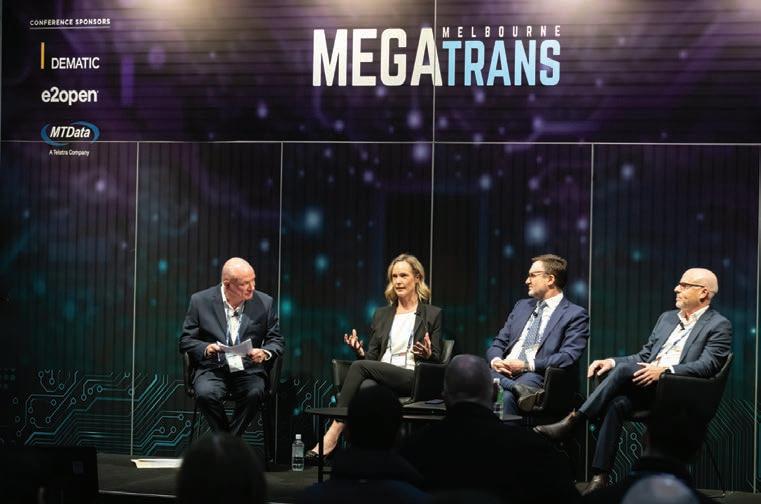
“We have pallet strapping, pallet caps, address labels – anything to do with people using plastic these days to ship products around,” Ross explained. “We want to make sure that it’s biodegradable and when it’s disposed of, it’s going to be recycled or biodegrade straight away.”

Meeting new people and connecting with old friends exemplifies what RWTA stands for – engaging and maximising the collegiate experience.
Marianne Kintzel, Executive Officer of the Refrigerated Warehouse and Transport Association of Australia (RWTA), provides a recap of what happened at the Association’s 80th conference and exhibition which was held in August, and reveals where and when the next one will take place.
The RWTA 80th Conference and Exhibition went off with a bang in Sydney this year!
It was a grand celebration with plenty to do. The three-day-long event started on Sunday August 21 with the Convict and Champagne Expedition at Campbells Cove at the Rocks experience to get delegates networking while enjoying sights of the Sydney Harbour.

In the evening there were cocktails followed by a welcome dinner at night. This was an opportunity for attendees to network.
Meeting new people and connecting with old friends exemplifies what RWTA stands for – engaging and maximising the collegiate experience. No better way to do trusted business than with those that you have met face to face, and post-COVID. Everyone was in the spirit of getting together and having a great couple of days!
It was all held at Marriott Pier One
Over Monday and Tuesday there were panel discussions and presentations on up-to-date topics by guest speakers.
Sydney Harbour, and its theme was “Achieving a Future Ready Supply Chain in an Era of Continuing Disruption.”
Over the Monday and Tuesday, there were panel discussions and presentations on up-to-date topics by guest speakers.
We aimed to provide attendees with access to knowledge, experiences, and networks in the Temperature Controlled Industry to assist them to create an informed future for them and their organisations.
Honourable Samuel Farraway started the event with his speech about regional transport and roads while Christine Corbett (Australia Post and more recently AGL) discussed the future of supply chain.
Troy Bryant (LOGOS) addressed the topics of reliability of the supply chain, automation, and e-commerce whereas Matt Ott, (Global Cold Chain Alliance) gave an international overview of the refrigerated warehouse and transport
industry worldwide.
Mark McKenzie (ACAPAMA) touched on fuel prices and international influences –to name a few.
Other key conference speakers were Marianne Kintzel – Executive Officer of the Refrigerated Warehouse and Transport Association of Australia; Jacob Mahoney – General Manager Energy Solutions at Flow Power; Kim Skubris – communications specialist; and Brett Wiskar – Chief Future Officer of consulting firm, Wiley.
The RWTA welcomed Graham Harvey of Newcold as its new chairman for the next three years. Ex-RWTA chairman, Jeff Hogarth of Lineage, led us for four brilliant years.
The conference and exhibition concluded with the Frank Vale Award for Future Leaders in the Cold Chain. This was judged and awarded at the Gala Dinner on the last evening. With a record number of participants and State Winners from Queensland, New South Wales, Victoria, South Australia, and Western Australia, the award went to Sydney-based Mark Jackson from Linfox.
The RWTA is pleased to announce its 2023 conference will be held at QT Gold Coast between the dates of August 20-22, 2023 and anticipates attendees from both Australia and abroad.

■
Marianne Kintzel, Executive Officer at the Refrigerated Warehouse and Transport Association of Australia (RWTA).






Completely redesigned and enhanced, the Geotab GO9 device is optimised for the collection and analysis of near real-time vehicle data. The GO9 features a faster processor, more memory, and a gyroscope. Expanded capacity allows even more and ongoing vehicle support, including better fuel usage support, and increased electric vehicle compatibility. Using Geotab’s patented tracking algorithm, the GO9 accurately recreates vehicle trips and analyses incidents. The GO9 also offers in-vehicle alerts to instantly notify drivers of infractions and –with hardware Add-Ons – provides live coaching for driver’s on-road performance.
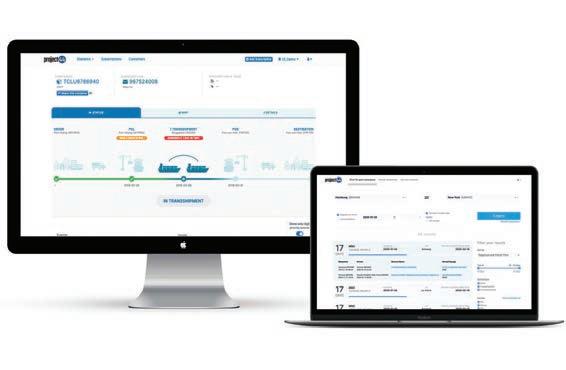


ifm’s O2I500 multicode reader is simple to use like a sensor, and reliably detects 1D and 2D codes. It delivers reliable reading results even in extremely difficult conditions, reading up to four different codes in milliseconds, which ensures efficient, and high-quality production. Thanks to the one-button teach function and the viewfinder, it makes the product immediately ready for use, saving time and costs. In addition to this, the O2I500 can be configured via an app or using the award-winning Vision Assistant software. The device has an exchangeable ifm memory stick, which can be used to save or load complete configurations of the multicode reader. This simplifies device replacement and the set-up of several units for the same application. The integrated optional illumination with polarisation filter, ensures sufficient contrasts to reliably detect codes even in the case of shiny surfaces such as metal. The ifm O2I500 multicode reader combines robustness, compelling design, and intuitive handling.
For more information visit www.ifm.com/au/en
Since Combilift launched its first C4000 model in 1998, multidirectional capability has been one of the major hallmarks of the company’s wide range of handling solutions. 24 years and thousands of R&D hours later, its latest product takes multidirectional capability to the next level. The Combi-MR4 is a 4-wheel electric powered multidirectional reach-truck, which incorporates Combilift’s new Dynamic 360° ™ steering, which provides rotation on each wheel, enabling seamless directional change of the truck while on the move. The system allows this extremely agile forklift to work in forward, sideward and crab steer mode, guaranteeing swift operation and excellent manoeuvrability. Hence the full name of the new model: the Combi-MR4 Dynamic 360.
For more information visit www.combilift.com/combi-mr4

Poor ocean visibility puts a strain on global supply chains, logistics costs, and customer service. At the root of the issue is low-quality data that hinders personnel productivity, streamlined operations, and proactive exception management. Today, more than ever shippers and 3PLs need global ocean visibility with the data quality, intelligence, ETAs, and proactive exception management that ensures efficient, cost-effective, reliable, and sustainable global transportation. project44’s Ocean Visibility solutions is here to help, with a suite of solutions that uses first-in-class data and analytics to improve personnel productivity, allow for proactive exception management, reduce logistics costs, improve customer service, and empower users for agile transport planning and procurement.
For more information visit www.project44.com
A monthly wrap up of the latest appointments in the supply chain, materials handling and logistics industry.

Graham Harvey has been elected as the new chairman of the Refrigerated Warehouse and Transport Association of Australia, having served the past four years on the RWTA’s Board of Directors. Graham is currently the Global Vice President Quality, Safety and Sustainability for NewCold after previously being the Regional Managing Director for Asia Pacific. Prior to NewCold he has worked in senior executive roles in operations and supply chain including 12 years with McCain Foods both in Asia Pacific and Europe.
Do you have career news to share?
Edward Cranswick at Edward.Cranswick@primecreative.com.au to be featured.

Operational design and product slotting using data science and analytics

We have a long history of providing material handling solutions, specifically tailored to solve the challenges faced by material handling & logistics business, providing significant improvements in efficiency and cost savings throughout your supply chain.




Our range of electric forklifts, Pedestrian forklifts and container loaders combine powerful performance, emission free operation and a host of up to the minute technologies to offer the most efficient way to handle long loads up to 120 tonne.

The Combi-CSS is the ultimate alternative to traditional container loading & unloading, able to safety load or unload a container in 6 minutes
To find out how Combilift can help you unlock every inch of your storage space

the Efficiency, Safety and Storage
of your logistics with Combilift